#the book of fate 1997
Explore tagged Tumblr posts
Text
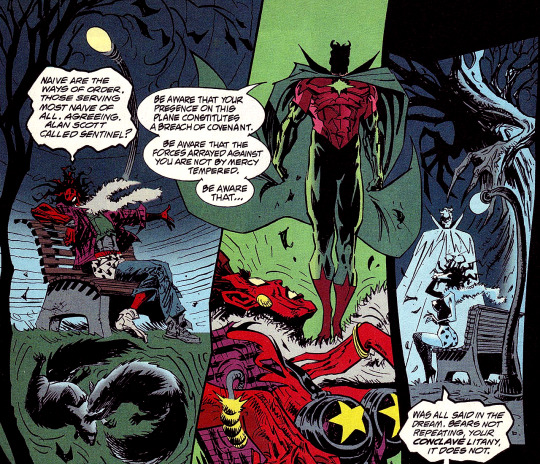



Hurt your feelings, have I? The Noble Knight of Order -- seeing yourself as that, are you? Then consider, Alan Scott called Sentinel... if order's essence defined your nature... you'd not have dreamed of me.
Alan Scott in The Book of Fate (1997) #2
(Keith Giffen, Ron Wagner)
#alan scott#green lantern#sentinel#the book of fate#the book of fate 1997#keith giffen#ron wagner#jsa#justice society of america#justice society#dc#dc comics#dcedit#comicedit#comicsedit#u can reblog#i've had to reread these for professional reasons and ive spent the past two days thinking about nothing else
20 notes
·
View notes
Text
Hi-Lo Arthuriana
Have a high interest in Arthurian Legend but low readability?
Here's a collection of adapted or abridged books to help ease you into the literary tradition. This list is ordered from simplest to most complex, beginning with picture books and ending with "translations" of Middle English texts into modern English or abridged versions of longer texts such as the Vulgate. Books in a series are numbered.
As always, if the book is still in print, I link to where you can legally purchase the book. Supporting living authors is very important! Otherwise, enjoy a PDF, on me, to keep the legacy of these authors alive.
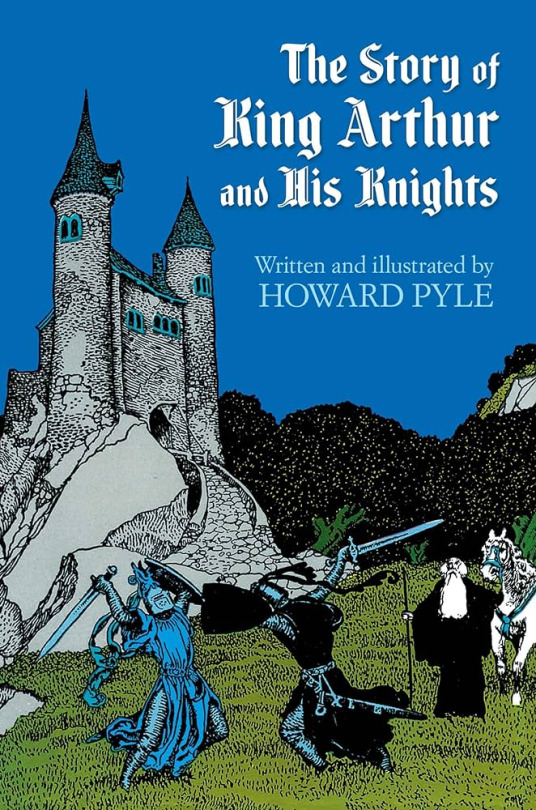
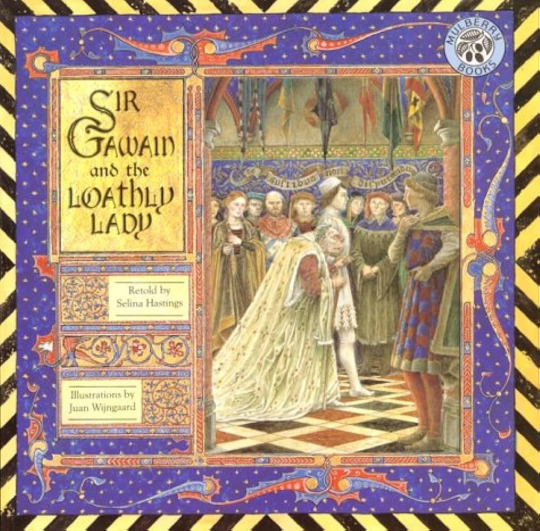
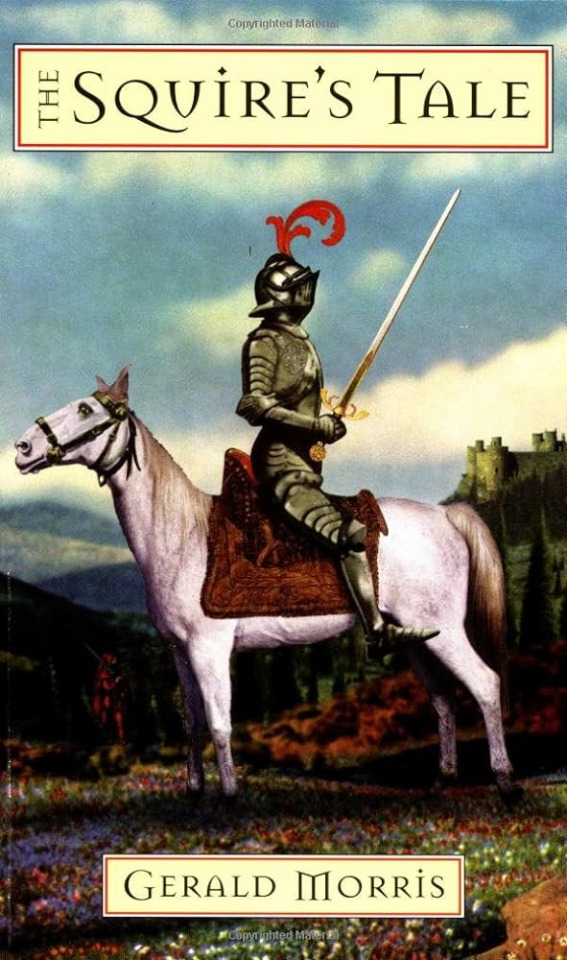
Picture Books
Young Merlin (Young Series #1) by Robert D San Souci & Jamichael Henterly (1989)
Tales From the Mabinogion Gwyn Thomas, Kevin Crossley-Holland, & Margaret Jones (1992)
Sir Gawain and The Loathly Lady by Selina Hastings & Juan Wijngaard (1985)
The Quest for Olwen by Gwyn Thomas, Kevin Crossley-Holland, & Margaret Jones (1988)
The Kitchen Knight by Margaret Hodges & Trina Schart Hyman (1990)
Sir Gawain and The Green Knight by Selina Hastings & Juan Wijngaard (1991)
The Tale of Taliesin by Gwyn Thomas, Kevin Crossley-Holland, & Margaret Jones (1992)
Young Guinevere (Young Series #2) by Robert D San Souci & Jamichael Henterly (1992)
The Knight with The Lion by John Howe (1996)
Young Lancelot (Young Series #3) by Robert D San Souci & Jamichael Henterly (1996)
Young Arthur (Young Series #4) by Robert D San Souci & Jamichael Henterly (1997)
Sir Gawain and The Green Knight by Michael Morpurgo & Michael Foreman (2004)
Perceval: King Arthur's Knight of The Holy Grail by John Perkins & Gennady Spirin (2007)
Comics
Prince Valiant by Hal Foster & many others (1937-present)
Camelot 3000 by Brian Bolland and Mike W. Barr (1982-1985)
Arthur, King of Time and Space by Paul Gadzikowski (2004-2014)
Tristan & Isolde: The Warrior and The Princess by Jeff Limke (2008)
Muppets King Arthur by Paul Benjamin & Patrick Storick (2010)
Gradalis WEBTOON [carrd] by @kochei0 (2021-present)
Chivalry by Neil Gaiman & Colleen Doran (2022)
Children's Chapter Books
The Adventures of Sir Lancelot the Great (The Knights' Tales #1) by Gerald Morris (2009)
The Adventures of Sir Givret the Short (The Knights' Tales #2) by Gerald Morris (2009)
The Adventures of Sir Gawain the True (The Knights' Tales #3) by Gerald Morris (2013)
The Adventures of Sir Balin the Ill-Fated (The Knights' Tales #4) by Gerald Morris (2013)
The Legends of King Arthur: Merlin, Magic, and Dragons (#1-#10) by Tracey Mayhew (2020)
Intermediate Retellings
The Idylls of The King by Alfred Lord Tennyson (1859)
The Story of King Arthur and His Knights (#1) by Howard Pyle (1903)
The Story of the Champions of The Round Table (#2) by Howard Pyle (1905)
The Story of Sir Launcelot and His Companions (#3) by Howard Pyle (1907)
The Story of The Grail and The Passing of Arthur (#4) by Howard Pyle (1910)
Hero Myths & Legends of the British Race by M. I. Ebbutts (1910)
The Squire’s Tale (The Squire’s Tales #1) by Gerald Morris (1998)
The Squire, His Knight, and His Lady (The Squire’s Tales #2) by Gerald Morris (1999)
The Savage Damsel and The Dwarf (The Squire’s Tales #3) by Gerald Morris (2000)
Parsifal’s Page (The Squire’s Tales #4) by Gerald Morris (2001)
The Ballad of Sir Dinadan (The Squire’s Tales #5) by Gerald Morris (2003)
The Princess, The Crone, and The Dung-Cart Knight (The Squire’s Tales #6) by Gerald Morris (2004)
The Lioness and Her Knight (The Squire’s Tales #7) by Gerald Morris (2005)
The Quest of The Fair Unknown (The Squire’s Tales #8) by Gerald Morris (2006)
The Squire’s Quest (The Squire’s Tales #9) by Gerald Morris (2009)
The Legend of The King (The Squire’s Tales #10) by Gerald Morris (2010)
Abridged Medieval Literature Translations
Sir Gawain and The Green Knight (Unrepresented #1) by Jessie Weston (1889)
Tristan & Iseult (Unrepresented #2) by Jessie Weston (1899)
Guingamor, Lanval, Tyolet, Bisclaveret (Unrepresented #3) by Jessie Weston (1900)
Moriaen (Unrepresented #4) by Jessie Weston (1901)
Sir Cleges, Sir Libeaus Desconus (Unrepresented #5) by Jessie Weston (1902)
Sir Gawain At The Grail Castle (Unrepresented #6) by Jessie Weston (1903)
Sir Gawain & The Lady of Lys (Unrepresented #7) by Jessie Weston (1907)
The Story of Sir Galahad by Mary Blackwell Sterling & William Ernest Chapman (1908)
The Romance of King Arthur and His Knights of The Round Table by Alfred W Pollard & Arthur Rackham (1917)
Le Morte d'Arthur by Keith Baines (1962)
The Lancelot-Grail Reader by Norris J. Lacy (2000)
Lancelot and The Lord of The Distant Isles by Patricia Terry, Samuel N. Rosenberg, & Judith Jaidinger (2007)
The Wedding of Sir Gawain and Dame Ragnell by David Breeden (????)
Informational Resources
Warriors of Arthur by John Matthews, Bob Stewart, & Richard Hook (1987)
The New Arthurian Encyclopedia by Norris J. Lacy (1991)
The Arthurian Companion by Phyllis Ann Karr (1997)
The Arthurian Name Dictionary by Christopher W. Bruce (1999)
#arthurian legend#arthurian legends#arthuriana#arthurian mythology#arthurian literature#arthurian preservation project#my post
455 notes
·
View notes
Text
youtube
Happy 8th Debut Anniversary, Gg! Since so many of your fans have already expressed their well wishes so beautifully, I'm just going to post my celebratory dance here 😁😁😁. (What? it's not like I can replicate any other of your or Dd's dance performances!! THIS IS YOUR (AND DD'S) FAULT.) (For those who have not seen this "dark history" gem video from Gg's X-Nine days — it's a rehearsal clip for the X-Nine Variety Show Ep4, aired December 2016 — lyrics + why this performance is in my BJYX treasure chest under the cut!!)
Okay, why don't I start with what the song is about? Published in 1997 by the aboriginal Taiwanese singer Ayol Komod 張震嶽 (Chang Chen-yue), the song is about a teenager's first heart break.
It got very popular because the tune's catchy, and because it's funny! The teenager in question.... definitely isn't the at-the-cusp-of-adulthood-YA-romance-male-lead type. Ayol admitted later that he got the inspiration of the song's grammatically Japanese name, 愛的初體驗, also known as 愛之初體驗 or 愛の初體驗 (Love's First Experience; の being the Japanese character for possessive), from a porn magazine cover in a Japanese convenience store.
(Japanese porn, more commonly known as AV, was (is?) an obsession for many teenage boys in the region, as one can imagine). Now, on to the lyrics. This poor teenager, how did he tell his heartbreak story?
如果說你要離開我 請誠實點來告訴我 不要偷偷摸摸的走 像上次一樣等半年 If you're leaving me, please honestly tell me. Don't sneak your way out, make me wait half a year like last time. 如果說你真的要走 把我的相片還給我 在你身上也沒有用 我可以還給我媽媽 If you're really taking off, give me back my photo. It's not useful on you. I can return it to my mom. 什麼天長地久 只是隨便說說 你愛我那一點 你也說不出口 What is everlasting (love)? It's just talk. What do you love about me? You can't even say. 你認識了帥哥 就把我丟一旁 天氣熱的夏天 心像寒冷冬夜 So you meet a handsome guy, and dump me to the side. Hot is the summer, but my heart is cold as a winter's night. 想要買酒來澆憂愁 卻懶懶不想出去走 想要來一包長壽煙 發現我未滿十八歲 Want to buy alcohol to douse my sorrow, but feel lazy and don't want to go out. Want to buy a pack of Longlife cigarettes, and realize I'm not yet 18. 是不是我的十八歲 註定要為愛情流淚 是不是我的十八歲 註定要為愛情流淚 Is it that my 18 years old is fated to shed tears for love? Is it that my 18 years old is fated to shed tears for love?
The "give the photo back to my mom" is usually when I burst into chuckles ... and makes sure I wouldn't place this teenager, age-wise, anywhere remotely close to adulthood 😁. The lower-end teenage age was suggested in Ayol's original music video too (https://www.youtube.com/watch?v=4shwLyB7690), in which toys were abundant, including Barbie and Godzilla figures representing the "girlfriend" (who probably thought of the teenager as no more than a kid) and the handsome guy.
I'd place this poor kid in early high school at the oldest, perhaps? Meanwhile, this kid was imagining himself as this tragic male lead suffering a romance-novel-worthy heart break. Hence, the use of phrases and analogies common in those books (such as everlasting 天長地久; literally, "long (in length) as the skies and long (in time) as the earth") and, more importantly, calling up "mature" imageries associated with heart break, of alcohol and cigarettes. These details, ironically, simultaneously gave away just how young he was, most telling being that he was not yet 18 years old, the minimum legal age at the time to purchase both in Taiwan. This explains Gg (and PCY's) awesomely silly moves in the dance, which matched the lyrics both in meaning and in style. While the lyrics isn't included in the video I posted, here's the shot of them playing the teenager handing his photo back to his mom after a swipe of it on his pants (0:36):

... imagining himself getting drunk (~1:13):

... and smoking (1:19):

I've gone through the performances on Youtube of this song (yes, because research is absolutely necessarily on something like this), and this is the only one in which the singer(s) accurately capture(s) the ... 小學雞 Xiao Xue Ji ness of the teenage narrator (Turtles all remember Xiao Xue Ji "Primary School Chicken", right?). Other performances tend to turn the song into a showcase of singing prowess, as is common and, as some of us may be reminded of over these last few days, necessary in performances intended for mainland China's audience (here's an example by Coco Lee (RIP): https://www.youtube.com/watch?v=uFOCMgB7UoA). While singing prowess is much appreciated, sometimes, an audience like myself just wishes for something fun. Something goofy. For a good laugh, to shout along to (I'd never call whatever escapes my voice box "singing"), to do celebratory dances with. This video delivers for me 😊. With similar sentiments, I prefer this video over the actual performance in the X-Nine Variety Show (https://youtu.be/F1jXP2R-zy4?si=N1Hg1IKwp-dRc_vM 2:10:05), which is more prepped, less casual. Gg mentioned in the show that this song is retro (the glasses were a nod to that; Ayol's MV also had retro elements), and I find the faded colors of the rehearsal video more complementing to this retro feel. Its camerawork was also much better at capturing the fake manga fight that made up so much of the heart of Xiao Xue Ji ness (a special shoutout to whoever feigned the Qi Gong reaction, who did it better than Gg's teammates in the actual show).
Hmm. What else? Oh, maybe, since I'm feeling self-indulgent (I think I say the same thing in every post?), let me share a little something personal that cements the place this performance has in my BJYX treasure chest. Some of you may have noticed the "Longlife cigarettes" (長壽煙) in the lyrics. The very ... curious brand name aside (Longlife? For cigarettes?), this is yet another element in the song in which the teenage narrator tries to create an image of maturity ... and only made him sound young. You see, in Taiwan, cigarettes had used to be sold by the government only, until 1987 when the government opened its market for foreign imports. "Longlife", a high-end cigarette line, had made its debut in the late 1950s. So the brand name, to be fair, had been created before the health effects of cigarettes were known. Regardless, the government's monopoly on cigarette sales allowed Longlife to own the vast majority (more than 3/4) of the marketshare until the foreign brands took over in the late 1980s, after which its sales plummeted.
"Longlife cigarettes" is therefore extremely well known in Taiwan — hence, its inclusion in the song, and to the point that the Taiwanese government, in the early 2000s, got caught in a dilemma + controversy of whether to rebrand the famous cigarettes, now that they were known to work against a long life. (It didn't.)
"Longlife cigarettes" is therefore also retro, the majority of its smokers being of the parents', and grandparents' generation. That our teenage hero thought of Longlife cigarettes — he had likely picked up that image from those generations above him, the "old people" — further suggested his knowledge about cigarettes wasn't from his peers (who would likely be smoking the foreign brands), because he was too young... ... Young, like me! (Hey, I * was * young in 1997!). Longlife just happened to be my grandpa's favourite cigarettes as well. It was ... at the turn of the millenium, a year or two after the release of this song, I think? When my mom told me how she used to light my grandpa's favourite cigarettes for him as a child. Predictably, the brand name made me cackle. Soon, with the Xiao Xue Ji spirit strong in me, it captured my imagination enough that the next time I visited Taiwan, I took a photo with a box of Longlife cigarettes at the airport's duty-free shop before bothering with things like Immigration and Customs. In the same ... chickenly spirit, therefore, I've already reported to my mom that Gg is / has the intention of smoking my grandpa's favourite cigarettes ... my grandpa who passed away before I was born. She has always been amused at my curious enthusiasm over that curious brand name, and she liked that it formed a curious connection between me and my grandpa. She, of course, knows about Gg and Dd, and my curious interest in them. On this happy anniversary, therefore, I may not have a photo to return to my mom, but I have this video and I'm sending it to her. * Duck Dances *
Ah, maybe along with Gg's other performances this week. He's only a superstar now, right? Right ❤️❤️❤️❤️❤️❤️❤️❤️.
PS. Gg, seeing you so happy at the concert the other day makes me wonder: can it possibly mean there will soon be good news to share with fans? Just ... curious 😁.
88 notes
·
View notes
Text
𝐒𝐡𝐨𝐮𝐥𝐝'𝐯𝐞 𝐬𝐚𝐢𝐝 𝐍𝐨 ✯ 𝐊.𝐓𝐬𝐮𝐤𝐢𝐬𝐡𝐢𝐦𝐚

"𝘼𝙣𝙙 𝙄 𝙨𝙝𝙤𝙪𝙡𝙙'𝙫𝙚 𝙗𝙚𝙚𝙣 𝙩𝙝𝙚𝙧𝙚, 𝙞𝙣 𝙩𝙝𝙚 𝙗𝙖𝙘𝙠 𝙤𝙛 𝙮𝙤𝙪𝙧 𝙢𝙞𝙣𝙙. 𝙄 𝙨𝙝𝙤𝙪𝙡𝙙𝙣'𝙩 𝙗𝙚 𝙖𝙨𝙠𝙞𝙣𝙜 𝙢𝙮𝙨𝙚𝙡𝙛 𝙬𝙝𝙮"
PAIRING. Tsukishima Kei x f!Reader
CONTENT. Angst, Cheating Tsukishima
Y/N and Tsukishima, a couple engaged to be married, until a shocking revelation of Tsukishima's infidelity rocks Y/N's world on the eve of their wedding.
WC. 3.4k
A/N. Writers block rn. I really liked the symbolism and metaphor and writing I used in this one so I hope you enjoyed it as well. I might rewrite my older and short ones cause I hate them so much. Anyways, Inspired by My Best Friend's Wedding (1997)
Not edited
Masterlink - Songs Unwritten

The sun dipped below the horizon, casting a warm glow over the city skylines where Y/N and Tsukishima's love story began. It was a place filled with memories and promises, but today, the air was heavy with uncertainty. Tomorrow was meant to be the day when Y/N would become Tsukishima's wife, the day they had eagerly awaited and planned for. Yet, fate had a cruel twist in store.
Y/N had always been a girl of hope and dreams. Growing up, she had always believed in love and soulmates. Her engagement to Tsukishima was supposed to be a fairy tale come true.
When she first met Tsukishima, Y/N couldn't help but be intrigued by his stoic and reserved demeanor on the volleyball court. It was a chilly autumn afternoon, and they were both participating in a local volleyball tournament. Y/N had always been drawn to the sport, and she eagerly observed the players, seeking to learn from their techniques and tactics.
As she watched the matches unfold, her attention was drawn to a tall and lanky tall young man in the middle position. Tsukishima's movements were precise and calculated, and he displayed a level of skill that impressed even the most seasoned players. However, what caught Y/N's attention the most was the intensity in his eyes and the way he seemed to keep his emotions tightly locked away.
Curiosity got the better of her, and during a break between sets, Y/N decided to strike up a conversation with him. "You're an excellent middle blocker. Your blocks are on point."
Tsukishima glanced at her briefly, his expression remaining impassive. "Thanks," he replied curtly.
Undeterred by his reserved response, Y/N continued, determined to break through his shell. "I've seen you play a few times before. Your techniques are impressive. How long have you been playing volleyball?"
"Since elementary school," he replied tersely, not offering any more information.
Y/N sensed his reluctance to engage in conversation, but she was determined to connect with him on some level. As the tournament progressed, she made small efforts to strike up conversations during breaks, asking about his favorite plays or how he got into volleyball. It was a slow process, but Y/N's genuine interest and friendliness gradually began to chip away at Tsukishima's guarded exterior.
Over time, they found themselves exchanging more than just volleyball-related conversations. They discovered shared interests in books, music, and even silly jokes that would elicit a rare chuckle from Tsukishima. Y/N learned that beneath his aloof façade, he had a dry wit that matched her own, and they found comfort in each other's subtle sarcasm.
As their conversations grew more frequent, Y/N noticed that Tsukishima's walls were starting to come down. He seemed more at ease, even cracking a genuine smile from time to time. Y/N was thrilled that she was able to break through the barriers he had built around himself.
Tsukishima's childhood friend, Asami, became a part of their lives too. They were the three musketeers, but little did Y/N know that the bond between Tsukishima and Asami was deeper than she imagined. They even had a lighthearted marriage pact with Asami, Tsukishima's childhood friend, that if none of them were married by the age of 30, they would marry each other.
But life took a different turn when Y/N came into the picture. Tsukishima and Y/N's connection was undeniable, and they fell in love deeply and irrevocably. Their love seemed to transcend the bounds of their childhood pact, and they decided to get engaged, looking forward to a lifetime of happiness together.
As the soft evening light streamed through the curtains, Y/N found herself lost in a whirlwind of memories. The room felt filled with echoes of laughter and whispered promises as she reminisced about the journey that led her to this very moment. Her fingers gently traced the delicate gold band adorning her finger – the engagement ring that symbolized the love story she had always dreamed of.
It was a lazy evening, and Y/N had decided to surprise Tsukishima with a visit to his home. The knot of anticipation tightened in Y/N's stomach as she approached Tsukishima's house. Tomorrow was meant to be the day of their long-awaited wedding, and she had come over to surprise him with the final touches they had planned together. A warm smile graced her lips, and she couldn't wait to see the look on his face when he saw the arrangements they had made.
However, as she pushed the door open, her heart plummeted to her feet. Right at the entrance, a pair of unfamiliar women's shoes lay neatly placed, catching her eye like a glaring beacon. Her mind struggled to process what she was seeing. Thoughts raced, but she couldn't deny the sinking feeling in her chest.
An unsettling sense of dread took over as Y/N stepped further into the house, her footsteps echoing in the silence. "Tsukishima?" she called, hoping for an explanation, hoping that she was wrong.
What Y/N saw shattered her world into a million pieces. There, in the dimly lit room, stood Tsukishima and Asami, their hands intertwined as they gazed into each other's eyes with a tenderness that was meant only for lovers. Y/N's breath caught in her throat as she tried to comprehend the scene before her.
Her voice quivered as she walked through the house, and the sight that met her eyes was a painful blow to her heart. In the living room, there they were – Tsukishima and Asami, sitting close together, their hands intertwined, their faces far too close for Y/N's comfort.
The room seemed to spin around her, and she clutched her chest, trying to steady her breath. Her vision blurred with tears, and she took a step back, unable to bear the betrayal before her.
Asami's eyes widened with guilt, and Tsukishima's face turned pale, realizing that their secret had been exposed. Y/N took a step back, her mind racing, desperately searching for an explanation or a reason that could justify what she had just witnessed.
The damage had been done, and Y/N could hardly bring herself to look at either of them.
"I-I can't believe this," Y/N whispered, her voice trembling with hurt and disbelief. "How could you do this to me, Tsukishima?"
Asami looked equally guilty, her eyes filled with remorse. "Y/N, we never wanted you to find out like this. It just happened, and we never meant to hurt you."
Y/N felt a mix of emotions – anger, betrayal, and heartbreak. Her whole world felt like it was crumbling around her, and she struggled to find her footing amidst the chaos of her emotions.
Tsukishima reached out to her, his voice filled with regret. "Y/N, please, let me explain. It's not what you think. It was a mistake, and I never wanted to hurt you."
"How can you say that?" Y/N choked out, tears streaming down her cheeks. "You knew how much I loved you, and yet, you chose to betray me."
The words hung heavy in the air, and the pain was palpable. Y/N turned on her heels and ran out of the house, feeling like she couldn't breathe. The world outside felt like a blur, but she kept moving, seeking solace and clarity amidst the chaos in her heart.
Y/N found herself standing on the same beach where she and Tsukishima had once shared beautiful moments. The waves crashed relentlessly against the shore, mirroring the turmoil in her soul.
She clutched the engagement ring on her finger, a painful reminder of the love and dreams that had shattered. The future she had envisioned had crumbled into pieces, leaving her heartbroken and lost.
At that moment, she didn't know what to do or where to go. But as she stared out into the vastness of the ocean. As Y/N stood on the beach, gazing out at the vast expanse of the ocean, she felt an overwhelming sense of despair. The crashing waves mirrored the turmoil within her, and she was torn between holding onto the love she once believed in and the pain of the betrayal that had shattered it.
Tomorrow was meant to be the day she had dreamed of – the day she would marry Tsukishima, her soulmate, and start a new chapter of their lives together. But now, it felt like all those dreams were being thrown away, lost in the depths of the ocean before her.
Her mind was a whirlwind of confusion, anger, and heartbreak. Part of her wanted to confront Tsukishima, to demand answers, to try and salvage what was left of their love. But another part of her knew that the trust had been broken, and nothing could ever be the same again.
As the sun set on the horizon, casting a warm, orange glow across the water, Y/N sank to her knees on the sand. She clutched her engagement ring tightly, feeling the weight of its symbolism in her hand. It was a symbol of the love they had once shared, but now, it felt like a painful reminder of the love that had been lost.
Her heart ached, not just for herself but for everyone who had been excitedly preparing for the wedding. Friends and family had come together to celebrate their love, but now, it seemed like it had all been a facade.
She closed her eyes, feeling the tears welling up once more. It wasn't just the wedding she was mourning; it was the future she had imagined with Tsukishima – the laughter, the shared dreams, the moments of love and understanding.
As Y/N stared out at the ocean, lost in her thoughts, a figure caught her eye in her peripheral vision. Turning her head, she saw Asami running towards her, her face etched with worry and concern.
"Y/N!" Asami called out, breathless as she reached her side. "I've been looking everywhere for you. Are you okay?"
Y/N felt a mix of emotions at the sight of Asami – the woman who had been at the center of the painful revelation. Part of her wanted to push her away, to demand answers, but another part yearned for someone to lean on in her moment of vulnerability.
Tears welled up in Y/N's eyes, and she turned her gaze back to the ocean, unable to meet Asami's gaze. "How could you?" she choked out, her voice trembling with hurt. "How could both of you betray me like this?"
Asami's face fell, and she knelt beside Y/N, her voice filled with remorse. "I know I can't justify what happened, and I never intended to hurt you, Y/N. It was a mistake, and I regret it deeply."
Y/N's heart ached, torn between wanting to hear an apology and wanting to push Asami away. "A mistake?" she whispered, her voice filled with bitterness. "Do you have any idea how much pain I'm in right now?"
Asami reached out to touch Y/N's hand gently. "I can't undo what happened, but I'm here now. Please, let me try to explain."
A part of Y/N wanted to turn away, to shut Asami out completely. But another part couldn't help but yearn for closure and understanding, as painful as it might be.
Taking a deep breath, Asami began to speak, her voice soft and remorseful. "It started out as innocent , Y/N. Tsukishima and I have known each other since childhood, and we had this marriage pact. But as we spent more time together recently, old feelings resurfaced, and we made a mistake. I'm so sorry."
Y/N listened, her heart torn between anger and sadness.
"Why didn't you both tell me?" Y/N asked, her voice trembling with emotion. "You were both going to let me marry Tsukishima without knowing the truth?"
Asami looked down, her guilt evident in her eyes. "We knew it was wrong, and we wanted to stop, but we were scared of hurting you even more. It was selfish, and I regret it deeply."
Y/N took a deep breath, her heart heavy with conflicting emotions. "He's got you on a pedestal but me in his arms," she uttered, her voice barely above a whisper. "Is that how it was all along? Was I just a place holder for him?"
Asami looked down, her gaze filled with guilt. "I can't speak for Tsukishima's feelings, Y/N. But I do know that you mean a lot to him. He loves you, but he also made a terrible mistake."
As Y/N stood there in front of Asami, clutching the engagement ring tightly in her hand, her tears fell like raindrops on a stormy night.
Just as she was about to speak, she heard a familiar voice call out her name. Tsukishima emerged from the shadows, his eyes filled with a mixture of sorrow and regret.
"Y/N, please," he pleaded, his voice cracking with emotion. "Give me a chance to explain."
But the pain within Y/N was too raw, too overwhelming to bear. "Explain what, Tsukishima?" she cried, her voice breaking with each word. "The lies, the betrayal? There's nothing left to say."
Tsukishima took a step closer, reaching out as if to touch her, but he hesitated. "I know I made a terrible mistake," he said, his voice choked with remorse. "But please, let me try to make it right."
Y/N's heart ached, torn between wanting to believe him and wanting to shield herself from further pain. "How can you make this right?" she asked, her voice filled with anguish. "You're engaged to me!"
As Tsukishima looked into her tear-filled eyes, his own filled with pain. "I was a fool, Y/N. I let my fear and confusion cloud my judgment. I never wanted to hurt you, but I let my emotions get the best of me."
Tears streamed down Y/N's cheeks, and she shook her head, unable to find the strength to forgive him just yet. "Why did you even ask me to marry you," she whispered, her voice barely audible above the crashing waves.
Tsukishima stepped closer, his desperation evident. "Please, don't throw the ring away," he implored. "It meant something once, and I want the chance to prove to you that it can mean something again."
In that moment, Y/N's heart wavered, torn between the love she had once shared with Tsukishima and the pain of his betrayal. The memory of the happiness they had once found in each other tugged at her heartstrings.
Summoning all the courage she had left, Y/N shook her head, tears falling like raindrops. "I can't, Tsukishima," she said, her voice resolute.
The weight of the engagement ring on her finger felt suffocating, a constant reminder of the shattered dreams and broken promises. Tears streamed down her cheeks, and she knew that she couldn't carry the burden of that ring any longer.
With trembling hands, she removed the engagement ring, the symbol of a love that had turned to betrayal. As she held it in her palm, her heart ached with the weight of the decision she was about to make. She looked at the ring, its delicate gold band gleaming in the fading light, and she knew that it no longer held the same significance it once did.
With a mix of pain and determination, she flung her arm forward, releasing the ring into the vast expanse of the sea. It glimmered for a moment in the sunlight before disappearing beneath the waves, swallowed by the ocean's depths.
As the ring vanished from sight, Y/N felt a sense of pain wash over her.
The sea seemed to embrace her grief, its vastness swallowing her sorrow.
As the ring disappeared beneath the water's surface, Y/N felt an overwhelming emptiness engulf her. The tears kept falling, and she knew that walking away from him wouldn't erase the pain she felt.
Her heart shattered into a million pieces, and the world around her seemed to blur into a haze of desolation. The love she had once believed to be eternal had crumbled, and she was left standing on the precipice of a dark and unknown future.
With a heavy heart, she turned away from the sea, Asami and Tsukishima, feeling the weight of the world on her shoulders. The beach, once a place of happiness and laughter, now held only memories of betrayal and heartache.
Days turned into weeks, and the ache in Y/N's heart showed no signs of subsiding. The pain of betrayal lingered, leaving her feeling lost and adrift. She tried to keep her distance from both Tsukishima and Asami, seeking solace in the company of friends who were always there to support her.
One evening, as she was going through old messages on her phone, Y/N stumbled upon a post. It was a picture of Tsukishima and Asami standing together, their arms wrapped around each other with smiles that felt like a cruel twist of fate.
As her eyes widened in shock, she began to scroll through the messages and discovered the truth. Tsukishima and Asami had indeed gone through with the wedding, sealing their love just a few hours after Y/N's heart had been shattered. They didn't want all that money and venue to go to waste and just like that her dreams were stolen from her.
The revelation hit Y/N like a tidal wave, knocking the breath out of her. It was a betrayal on a whole new level, as if the universe was conspiring against her, mocking her pain. The two people she had trusted the most had found comfort in each other, using their deceit to validate their actions.
"How could they?" Y/N whispered, her voice cracking with disbelief. It felt like a knife through her heart, adding salt to the wounds that were still raw and bleeding.
The sense of betrayal and hurt overwhelmed her, and she felt a mix of anger, sorrow, and confusion. It was as if the world had collapsed around her, and she found herself questioning everything she once believed in.
At that moment, Y/N couldn't see a path forward. The pain was all-consuming, leaving her feeling lost and broken. She wanted to scream, to demand answers, but the bitter reality was that there were no answers that could mend her wounded heart.
In the distance, the sun began to set, casting a melancholic glow over the apartment. As darkness descended, it mirrored the darkness that had settled within Y/N's soul.
Grief washed over her in waves, as she mourned not only the love that was lost but also the future that could have been. She pictured the life they had planned together – a home filled with love, laughter, and children, growing old hand in hand.
But now, those dreams lay shattered, scattered like fragments of glass on the cold ground. The pain was all-consuming, leaving her feeling adrift and lost in a sea of sorrow.
Y/N felt as if her heart was like an artist's scrapped work discarded in the trash bin. The pain of the shattered love was akin to the pain of watching something she had poured her heart and soul into being tossed aside, unappreciated and unwanted.
The canvas of their love story, once filled with vibrant colors and promising strokes, now lay in ruins, torn apart by deceit and betrayal. She could almost see the paint splattered across the floor, an abstract representation of the chaos that had consumed her emotions.
She had invested so much in this masterpiece, carefully adding each brushstroke with love and hope. But as fate would have it, the canvas had been marred beyond repair, leaving her feeling like an artist who had lost her way.
Her memories served as a painful reminder of what could have been – a love story that was meant to be cherished and admired. Instead, it had been abandoned, a casualty of human flaws and weaknesses.
She felt like a shell of her former self, her spirit bruised and battered. The red strings of fate that she had once believed in now felt like a cruel joke, a reminder that love didn't always lead to happiness.
Fate had played a cruel trick, entangling her heart with the wrong person, and how she was left to untangle herself.
©Minarixx 2023 - please don't copy, repost or translate without my knowledge credit or permission.
#haikyuu#haikyuu angst#haikyuu one shot#haikyuu x reader#hq oneshot#haikyuu x female reader#haikyuu x self insert#tsukishima x you#tsukishima kei#tsukishima x reader#tsukki#tsukishima kei x you#tsukishima kei x reader#kei tsukishima#tsukishima x y/n#tsukishima angst
391 notes
·
View notes
Text
mordred through time (movies, tv shows, opera and musicals)
Part 5: From 2018 to 2023 (and 2024)
Other Parts: Part 1: From 1949 to 1981 -> here Part 2: From 1982 to 2002 -> here Part 3: From 2002 to 2010 -> here Part 4: From 2014 to 2017 -> here
For this last part I wanted to talk a bit about queer Mordred!
First of all, Mordred is one of the main characters who is written as LGBTQ in novels and other media. My arthurian excel list of queer arthurian characters (arthurian list of everything, in the LGBTQ sheet) is up to a few years ago, but the numbers seem to be: LGBTQ Lancelot in 16 media, Arthur in 13 media which is equal to Mordred who is also LGBTQ in 13 media (two being interpretations: White's "The once and future king" and "Fall of Camelot" fromt he Time Life books). Most of these are, of course, novels, with the first ever appearance of LGBTQ Mordred in 1956 Borowsky's novel "The Queen's knight", where Mordred is a gay man. Then in 1982 Cherryh's "Port Eternity" has asexual Mordred, even if the characters could be debated on how arthurian they are. We then jump to 1997 with the short story "The Pretender" by Stephen Dedman, with mlm Mordred.
2005 "A Connecticut Fashionista in King Arthur's Court" by Mari Mancusi (gay Mordred) 2006 "Mordred bastard son" by Douglas Clegg (gay Mordred) 2008 "The Silurian series" by Wilson (gay Mordred) 2012 "The Prince and the Program" by Mercer (bisexual Mordred) 2014 "Mordred and the king" by Curlovich (gay Mordred)
In movies, shows and musicals instead we could consider 2008 musical Mordred the first iteration of queer Mordred (part 3). This is of course an interpretation and it might probably just be a case of queer-coding of villains that reminds of Disney movies. Still, there is no doubt Bobby Steggert, who is an out gay actor (at the time, now he is a therapist) played an obvious queer coded Mordred.
It is only in 2014 that we have an explicit LGBTQ Mordred with "High Noon over Camelot" which also for the first time ever introduces Mordred as a trans man. From 2017 we also get introduced to Fate's Mordred (Fate/Aprocrypha and subsequient movies and stage shows) whose gender has always been a debated topic. I already talked about it in part 4, but Mordred in Fate is definitely written as a non binary character. In 2018 the webseries "The Campaign for Camelot" has Mordred as a protagonist and mlm, with a romance as well (another male character in the show). The last time we saw Mordred with a romance was back in the 60s, in the movie "Sword of Lancelot"!
I think the most interesting thing is that Mordred is without a doubt the character who is the most interpreted as LGBTQ in movies and tv shows. From memory, the only other characters are Morgana (in the Netflix's "Cursed", webseries "Legend" and "The Campaign for Camelot"), Lancelot (in "Monty Python and the Holy Grail", "High Noon over Camelot" and "Spamalot"), Galahad (in Josh Ritter's song "Galahad"), Arthur ("High noon over Camelot") and Merlin (webseries "Legend").
2018 Arthur et les enfants de la Table Ronde: This is a two-seasons French animated show that narrates the adventures of Arthur, an orphan kid living in Uther's kingdom. The show has other arthurian characters as kids (Guinevere, Gawain, Sagramore, Morgana) and Mordred himself is also a kid. Morgause and Igraine (Morgana's sisters) are the main villain and Mordred (their cousin) is also a villain. The voice from the clip is from the Italian dub but the original French voice actor was Ricardo Richter.
2018 The Campaign for Camelot (webseries): This websites (you can watch it here) is a complete 78 short episodes series where different modern arthurian characters decide to run for the school board against Arthur's wishes. Mordred is one of the main protagonists and he is introduced in episode 7. Over the series he also develops a romance with Izzy (Iddawg, from “The Dream of Rhonabwy”). To clarify, in the clip Mordred is the guy without the glasses and the darker shirt! And he is played by Dylan Martin.
2018/2019 OSK's Knights of the Round Table musical: This clip is from a recording but a dvd also exists. OSK is a Japanese theater company of all women. Mordred was interpreted by Momo Mika. The story of the musical follows the classical Arthur-Guinevere-Lancelot triangle with Mordred appearing (as Arthur's son) in the second part of the story.
2020 Arthur and Merlin: Knights of Camelot: A much less exciting movie than I expected, focusing on Arthur trying to reclaim Camelot after Mordred betrays him. Mordred (played by Joel Phillimore) plays Arthur's son and the villain of the story. He often uses threats of sexual violence towards Guinevere.
2020 Fate/Grand Order the movie: Camelot: Another installment in the Fate series. This movie is set in the Grand Order timeline (different from Apocrypha), but Mordred is still a very similar character and they are still voiced by Miyuki Sawashiro. The original title is Fate/Grand Order: Shinsei Entaku Ryouiki Camelot 1 - Wandering; Agateram as in 2020 only part 1 released. Part 2 is called Fate/Grand Order: Shinsei Entaku Ryouiki Camelot - Paladin; Agateram and was released in 2021. Basically part one is Wandering Agateram and part two is Paladin Agateram. Different from other Fate series, this one is set in the past (in 1273 A.D.).
2021 Fate/Grand Order: The Grand Temple of Time: Another movie based on the videogame Fate/Grand Order... please do not ask me the plot, I just know Mordred is not as present here as in the previous movie or as in Fate/Apocrypha.
2021 Le Roi Arthus opera: This is a 1895 opera written by Ernest Chausson and sung in French. I already talked about it before, just know this is the most recent iteration of it and the only video we have of the opera performed in arthurian clothes (the previous filmed performance was a modernization). Mordred was played by baritone Justin Austin.
2023 Camelot Revival: The return of the musical Camelot! There are a few bootlegs around (at least 4 of them) if you want to watch it, but I am not allowed to share them. Still, I got them from asking a gift on the reddit BootlegsGifts. As I still have to watch it I cannot comment on any possible difference here, just know this version was extremely successful. Mordred is played by Taylor Trensch, and Hawley Gould was his understudy (not in audio).
#mordred through time#mordred#camelot#camelot revival#arhturian legend#camelot musical#le roi arthus#opera#musical#video#arthur and merlin#the campaign for camelot#arthur et les enfants de la table ronde#characters through time#lgbtq
22 notes
·
View notes
Text
Codebearers by The Miller Brothers (2008-2010)
After one of his infamous pranks backfires, Hunter unexpectedly finds himself in possession of an ancient book and key. Little does he know the mysterious book is a gateway to Solandria, a supernatural realm held captive by the Shadow. In Solandria, Hunter joins forces with the Codebearers, a band of highly trained warriors who form the Resistance to the Shadow. But before he can complete his training in the ways of the Code of Life, Hunter is sent on a mission far more dangerous than he ever bargained for. Now with his life in peril and the future of Solandria hanging in the balance, Hunter is headed for a showdown with the Shadow and a battle to save his soul from a fate worse than death! Is Hunters knowledge of the Code deep enough to uncover the secret of the Shadow, or will the truth be more than he can bear?
Merovingen Nights by C. J. Cherryh (1985-1991)
Merovin, the world the C. J. Cherryh built, a low-tech, inhospitable planet where the human survivors of a colony nearly destroyed by an enigmatic alien menace still dwell, salvaging what they can, while awaiting the return of the alien menace or rediscovery by the Terrans who abandoned them in that long-ago terror.
And in Merovingen, the fantastic canal city, where the wealthy and powerful reside in the highest towers, and beggars, spies, thieves and boaters like Altair Jones ply the highly polluted interlacing waterways below, intrigue, thievery and revolution are the very breath of life. And now with the Festival of Scouring approaching, C. J. Cherryh has invited some of today's finest writers into Merovignen, to weave together this tale of Festival Moon, a time of mystery and murder, of power games both high and low, a Festival after which this world will never be quite the same again...
Dragonlance: The New Adventures by Tim Waggoner (2004-2008)
Nearra does not know who she is or where she lives, but she does know one thing: someone wants her dead. Her only hope lies leagues away, in an ancient temple, where healing clerics may be able to restore her memory.
A helpful young ranger, a failed warrior, a sneaky elf, and a kender wizard offer to accompany Nearra on her journey. She soon learns her newfound friends have secrets of their own. As goblins, an angry minotaur, and a vicious green dragon attempt to stop them at every turn, friendships are tested and all of if may come to ruin from the one Nearra trusts the most.
Creature Court by Tansy Rayner Roberts (2010-2018)
A war is being fought in the skies over the city of Aufleur. No one sees the battles. No one knows how close they come to destruction every time the sun sets.
During daylight, all is well, but when nox falls and the sky turns bright, someone has to step up and lead the Creature Court into battle.
Twelve years ago, Garnet kissed Velody and stole her magic. Five years ago, he betrayed Ashiol, and took his powers by force. But now the Creature Court is at a crossroads … they need a Power and Majesty who won’t give up or lose themselves in madness …
Spellbound by Vivian Vande Velde (1997-1998)
Welland was less than a slave. Slaves are human, and he was wolf, allowed to assume human form only when it suited the sorceress Daria.
Daria kept an army of changelings mostly wolf but some lynx or weasel, a bear or two, and at least one rat. She used them to hunt and kill. And sometimes to pretend to be human, so she could pretend to be a lady.
Weiland hated the lie almost as much as he hated the truth. Then he met a burglar, a thief named Shile, who offered to help him steal what he had never owned. His own troubled soul...
Welkin Weasels by Garry Kilworth (1997-2003)
Long ago, long before Sylver the weasel was born, the humans all left Welkin. Now life for a weasel—under the heavy paw of the vicious stoat rulers—is pretty miserable (unless you happen to be a weasel who likes living in a hovel and toiling all hours for the benefit of the stoats).
It's certainly not enough for Sylver. Or for his small band of outlaws, both jacks and jills. but slingshots and darts can only do so much against heavily-armed stoats and life as an outlaw has a fairly limited future (probably a painful one, too). That's when Sylver comes up with his plan—a heroic plan that could destroy the stoats' reign of power for ever. He will find the humans, and bring them back to Welkin! And the first step is to follow up a clue from the past—a clue that lies in a place known as Thunder Oak...
Evergreen by Devin Greenlee (2024)
All seventeen-year-old Quill wants is a break from the family business. Flowers, plants, the generations-old garden. What he wouldn’t give for a taste of the outside world. Normalcy. But his mom won’t let him out of the house, telling him he’s just not ready…
All because he’s a dryad. Well, not just any dryad, but a male dryad—the first ever. And unlike everyone else in his family, he hasn’t a lick of magic. Just a shock of green hair, matching green eyes, and a growing frustration that there’s an entire world out there waiting to be discovered. Until the night when the outside world—specifically his new neighbor—discovers him.
Liam Watson lives in a culture filled with electronics, mobile devices, and social media—where there is no magic or even the belief in it. And as much as Quill finds Liam irritating (he’s so cute it’s annoying), he can’t help himself.
Now Quill’s getting a taste of the outside world and of Liam…and he wants more. But all is not well in this magical, urban garden, and someone—or something—is changing the very essence of it.
And wherever Quill goes, the danger grows…
Unicorns of the Mist by R. R. Russell (2013-2014)
Deep in the heart of a mist-shrouded island, an impossible secret is about to be discovered.
Twig is used to feeling unwanted. Sent to live on a pony ranch for "troubled" girls on a misty, haunted island, Twig is about to discover the impossible — someone who needs her. Jolted awake from a bad dream, Twig follows the desperate whinny of a terrified horse out to the stables. There in the straw is a bleating little scrap of moonbeam. A silver-white filly with cloven hooves and a tiny, spiraling horn.
A baby unicorn.
Now Twig knows what secret is hiding in the island's mist: the last free unicorn herd. And a mysterious boy named Ben who insists that this impossible creature is now Twig's to care for. That she needs Twig's love and protection. Because there's something out there in the deep, dense shadows that's hunting for them...
Chronicles of Avilesor by Sara A. Noe (2020-2021)
Cato is the only true half-human, half-ghost hybrid in existence. He's powerful and unique with two divine powers instead of one.
The United States government believes he is the key to developing a devastating weapon that will give humankind an advantage when war inevitably erupts between the Human Realm and Avilésor, the Ghost Realm.
After being an unwilling test subject in Project Alpha for two years, Cato and the rest of his "lab-family" survive a transport accident to find themselves stranded and powerless in the middle of the wilderness. Hunted every step of the way by ghostly Shadow Guards with supernatural abilities and human Agents desperate to recapture their prisoners, the eight young fugitives are drawn to Cato's hometown where the Rip between Realms connects the worlds.
Cato wants nothing to do with his past, but as his enemies close in, he realizes he's willing to do anything to protect his lab-family . . .
. . . even kidnap the daughter of a ghost hunter and make a dangerous deal to become a mercenary.
Knights of Liofwende by Garry Kilworth (2002-2004)
Faerieland. It's like a reflection of your world... a warped reflection. And Jack has just stumbled right into it - with a whole lot of trouble on his tail. Trolls, goblins, ogres and giants ... all after one thing. But Jack's got no clue what. He needs some allies, like now. A wizard maybe. Or a High Fairy. Someone who can do serious magic. Someone who can help him get home. Anyone. Just not a dreamy young boggart named Spiggot...
#best fantasy book#poll#codebearers#merovingen nights#dragonlance: the new adventures#creature court#spellbound#welkin weasels#evergreen#unicorns of the mist#chronicles of avilesor#knights of liofwende
19 notes
·
View notes
Text
Editor's Note from The Black Sands of Socorro by Patricia A. Jackson

While researching Patricia A. Jackson’s entire body of Star Wars work for a short story anthology, I came across the West End Games sourcebook Star Wars: The Black Sands of Socorro (1997.) It’s a crucial work of Star Wars ephemera: The first creator of color writing for Star Wars in an official capacity, writing not just about individual characters of color, but centering entire cultures populated by non-white characters. A young Black woman in the 1990s wrote science fiction for Star Wars, worldbuilding with concepts like antislavery, indigeneity, linguistic divergence, and settler colonialism...while Disney-Lucasfilm in the 2020s ineffectually positions Star Wars as a post-racial fantasy.
I non-hyperbolically refer to Patricia A. Jackson as the “Octavia Butler of Star Wars,” not because fans of color need to be officially sanctioned by Lucasfilm to create Star Wars content, but because of how difficult it is to carve out anti-racist space in a transmedia storytelling empire. Challenging even in transformational fandom spaces (e.g. fan works), to broach race in affirmational fandom spaces—or while writing content for the property holder—is to be unflinchingly subversive.
And Jackson did it first. In an interview with Rob Wolf in 2022, Jackson described her experience writing race into Star Wars in the 1990s as an “experiment.” The planet, peoples, and cultures of Socorro were a way for Jackson to obliquely, yet concretely, center Blackness and racial justice into Star Wars, pushing the racial allegory constrained by the original trilogy to its limits.
Since it’s inception, Star Wars has spent much of it’s storytelling on the fringes of the galaxy (whether it’s Tatooine or Jakku, Nevarro or Ajan Kloss.) The Black Sands of Socorro is an extension of that trope, but where the Star Wars films used indigeneity as set dressing (eg. “Sand People”, Ewoks, Gungans, etc.) Jackson creates a vivid world where indigenous culture and settler colonists collide; where characters are coded with dark skin and central to the action. The planet Socorro is distinct as a Star Wars setting. As one of the only places in the galaxy where slavery is eradicated with a vengeance, Socorro refuses to let go of a plot line Star Wars media often leaves behind. Socorro is a haven from Imperial fascism, a space where readers are invited to imagine a story that does not center around occupation.
When I learned that Patricia A. Jackson no longer has a physical copy of The Black Sands of Socorro, I realized that I had the materials and the means to create a fanbound hard copy for her home library (well, and also for my own home library.) While this handmade book is not an exact reproduction of the RPG supplement, I hope my renvisioning of the supplement as an in-universe travel guide lives up to the original work.
As the idea of creating a travel guidebook based on the original material percolated, I reflected on the State of Race in Star Wars in the year since I compiled Designs of Fate, an anthology of my favorite Patricia A. Jackson short stories. In May 2022, actress Moses Ingram debuted as Inquisitor Reva Sevander, the deuteragonist in the Dinsey+ streaming Obi-Wan Kenobi series. As predicted by Lucasfilm—and any fan sick of alt-right Star Wars related “whitelash”—Ingram was promptly subjected to a firehose of racialized harassment and misogynoir.
Yep, fascist self-proclaimed fanboys complained about a Black woman Inquisitor in 2022, having no idea (or deliberately whitewashing) that one of creators of the entire freakin’ concept of Inquisitors was a Black woman writing for the Star Wars Adventure Journal three decades ago.
Then, a public facing Star Wars account (@StarWars on Twitter) broke precedent and slapped back at the trolls. Lead actor Ewan McGregor filmed a video retort, posted on @StarWars, stating “racism has no place in this world” and telling off the racist bullies: “you’re no Star Wars fan in my mind.” A few months later, Disney+ debuted it’s second flagship Star Wars streaming series of the year, starring a Latino actor as the protagonist. In the opening episode of Andor, a police chief describes Diego Luna’s eponymous lead as a “dark-featured human,” perhaps the closest the franchise has ever gotten to acknowledging out-of-universe constructions of race, to date. The series explored aspects of imperialism with more depth than Star Wars had previously done on screen, such as the Empire’s treatment of the native people of Aldhani. And, in November, the The Acolyte, a Disney+ series co-developed by Rayne Roberts, announced Amandla Stenberg and Korean actor Lee Jung-jae as its top-billed leads. Stenberg will be the first Gen Z, mixed race, Black, Inuit, queer, and non-binary actor to lead a major Star Wars series.
On the Patricia A. Jackson Star Wars front, in 2022, Jackson’s character Fable Astin was an easter egg in the Obi-Wan Kenobi series. Jackson will again write for Star Wars in an official capacity in From a Certain Point of View: Return of the Jedi, due for publication in Fall 2023. A series about Lando Calrissian, the galaxy’s most famous Socorran, is still in production, so I have my fingers crossed that we may soon see Socorro on camera.
I wonder if this past year will have been a fulcrum year for BIPOC fandom. Maybe Disney has finally realized it’s bad for business that the alt-right uses social media algorithms and Star Wars fan spaces as a soft recruiting ground to radicalize young white men? Maybe Star Wars as a franchise will continue to loudly disavow fan whitelash and firmly position performers of color in true leading roles? I really hope so. On the other hand, as much as I am in favor of increased representation in Star Wars storytelling, I am also troubled by Disney-Lucasfilm’s framing of the Galaxy Far, Far Away (GFFA) as “colorblind.” Recently, Star Wars fans have been asked to accept that in the (a long time ago) sci-fi futurepast GFFA, humans have always been post-racial, and it’s just a coincidence that racialized people were not caught on camera the way white characters have been for years. The galaxy is post-racial and it’s just acoincidence that the movers and shakers of the galaxy have largely been depicted as white men for the past 40 years of media.
For example, in the decade since Disney rebooted the expanded universe, fans have learned that Star Wars’s biggest galactic war criminal to never be depicted on screen is Admiral Rae Sloane, a bisexual Black woman who was the leader of Imperial remnant forces, one of the architects of the First Order, and personal mentor to General Hux. Under Disney-Lucasfilm’s post-racial retcon of the Star Wars universe, the allegorical fascists are intersectional equal opportunity employers (at least in expanded universe content like animation, video games, and novels.) Along those lines, several of the franchise’s newly introduced, prominent women of color have been part of the Empire: Imperial loyalist Cienna Ree (Lost Stars), Inferno Squad leader Iden Versio (Star Wars: Battlefront II) former stormtrooper Jannah (Episode IX), First Order pilot Tamara Ryvora (Star Wars: Resistance), Inquisitor Trilla Sundari (Jedi: Fallen Order), Captain Terisa Kerrill (Star Wars: Squadron) and, most recently, Inquisitor Reva Sevander. Once the sole purview of stodgy, very white and very British men (demonstrably so even in the sequel trilogy movies,) now anyone can be a stooge of the Empire.
That’s not to say that marginalized people can’t collude with fascism, or that there haven’t been heroic characters of color introduced in recent years. Rather, I posit that in order to sell audiences on the post-racial/colorblind GFFA, fascist-of-color characters like Rae Sloane or Giancarlo Esposito’s Moff Gideon (The Mandalorian) are created by necessity. The franchise wants to at once be racially inclusive and yet never directly address race. In Star Wars, real world oppression is primarily explored through allegory—such as Solo (2018)’s bit on droid rights, the clone army, or the myriad of non-human alien bodies that nonetheless are coded with racial stereotypes. A lot has been said about how allegory in sci-fi allows audiences to grapple with inequality from a comfortable distance, and not enough has been said about which audience is being prioritized for comfort.
What does it mean when race is supposedly a non-issue for humans in the GFFA, but creators and actors with marginalized identities cannot participate in Star Wars in any capacity without experiencing identity-targeted harassment? In the past ten years, this has been true even for white women like Kathleen Kennedy and Daisy Ridley, but the vitriol has been most strongly directed towards Black women like Lucasfilm Story Group lead Kiri Hart, author Justina Ireland and The High Republic Show host Krystina Arielle. Can the Galaxy Far, Far Away truly be “colorblind” or “post-racial” (never-racial?) if the narrative continually centers white characters and replicates all the common racial inequities seen in commercialized Hollywood storytelling? Upon the release of The Force Awakens in 2015, critic Andre Seewood aptly described Finn’s positioning in the story as “hyper-tokenism,” even presciently predicting that Finn would continue to be hyper-tokenized in Episodes VIII and IX. As the narrative veered away from Finn, it also left unrealized a stormtrooper rebellion plot line where Finn could have been, in effect, a Black abolitionist. Actor John Boyega’s critique of his experience in the sequel trilogy aligns with Seewald’s assessment: “Do not bring out a Black character, market them to be much more important to the franchise than they are and then have them pushed to the side.”
Published in 1997, The Black Sands of Socorro came before Finn, before Mace Windu, back when all the melanin of Star Wars could be found in Billy Dee Williams’s singular swagger and James Earl Jones’s distinctive voice. Back then, the most prominent Black actress in the original trilogy was dancer Femi Taylor, who played Oola, the hypersexualized green twi’lek fed to the rancor in Return of the Jedi. Bantam Spectra, the publisher that held the license for Star Wars from 1991 to 1999, had no leading characters of color in its’ Expanded Universe. The first full length Star Wars novel by a writer of color, Steven Barnes’s The Cestus Deception15, would not be published until 2004. Even though the book featured two protagonists of color, they would not be depicted on the cover. At Comic-Con in 2010, I spoke with Tom Taylor, a white Australian comic book writer who tried to make the lead family in Star Wars: Invasion (2009) a Black one, but was shut down during the creative process. The comic instead depicts a family of blondes, because the publishers did not think fans would embrace leads of color. All this to say, the inclusion of melanated characters in Star Wars has been so, so hard fought. It’s incredible The Black Sands of Socorro exists at all. It’s more than worthy of celebration, and I’m floored that more attention has not been brought to it.
Patricia A. Jackson is a smuggler.
This sourcebook was explicitly written to assist fans in telling their own Star Wars stories, and in it Patricia A. Jackson smuggled in emphatic allusions to the Black Panther movement and the trans-Atlantic slave trade, smuggled in commentary on indigeneity and settler colonialism, and smuggled in multiple ways for fans to envision characters of color. Her writing has consistently added richness to the GFFA, and in The Black Sands of Socorro she envisions multiple histories for multiple cultures coded as non-white. She ensured the existence of not mere tokens, but flourishing societies of people of color in Star Wars.
The coda for The Last Jedi again shows how perilously close to tokenization characters of color, particularly Black characters, are in modern day Star Wars. In this film, the franchise returns to itsprevious exploration of slavery with the depiction of enslaved children on Canto Bight. The last speaking lines of the film are from Oniho Zaya (played by Josiah Oniha, a young Black British actor) who recounts Luke Skywalker’s heroic exploits to the other children. The film then closes out by showing that one of the downtrodden children is Force-sensitive—a future hero in the Star Wars mythos. In a film where every single Force-user depicted is white, the next generation kid with the potential is, again, a young white boy. Once again, the Black character can only serve the narrative in a supporting role. A franchise depicting a colorblind fantasy continually reifies racial and gender hierarchies in America. With The Acolyte, scheduled for release in 2024, it’s possible the franchise may finally be shifting past hyper-tokenism. In the meantime, fans of color and our erstwhile allies will continue doodling in the margins.
In the end, the sequel trilogy left the Canto Bight plot line (and the overarching slavery plot line started in Episode I) unresolved. I’d like to think the Black Bha’lir strafed Canto Bight and grabbed those kids. It seems like something they would do. Out among the stars, Oniho Zaya is adventuring with Drake Paulsen, and his story does not bracket another characters’; he is central. The Black Sands of Socorro is a launching pad for stories like that. It represents how fans of color have always carved out pieces of Star Wars for ourselves.
#socorro#star wars legends#swrepmatters#star wars adventure journal#star wars d6#patricia a. jackson#fanbinding#binders note
35 notes
·
View notes
Text
i have lots of artbooks btw (some are in cbz which needs a reader, i recommend sumatra pdf for windows, most are zip files with jpegs tho) most of these i got from nyaa dot si (if you torrent it'll go heaps quicker)
i might be a little slow with setting things up (megadrive or googledrive, i haven't uploaded most of these yet) but hit me up if you're interested in any of the following ;-)
angel sanctuary - angel cage artbook
angel sanctuary - lost angel artbook
abe yoshitoshi artist compilation
akira 1988 (storyboard + artbook)
akamichi art works
berserk mini art collections
berserk movie artbook (bg art edition)
blasphemous artbook
boogiepop phantom artbook - kouji ogata
claymore memorabilia illustration book / artbook + promo
cowboy bebop artbooks
dantalian animation artbook
exist - takeshi okazaki (popular edition artbook)
fool's art gallery (homare) - purple hair
final fantasy X-2 visual arts collection v2
ffix visual arts collection
g
halo artbook
hell girl artbook - kyouka suigetsu
jojo's bizzare adventure (artbooks & spinoffs)
kingdom hearts visual art collection
kenichi sonoda artworks 1983-1997
love hina art collection
makai kingdom mini artworks
metal gear solid artbook - yoji shinkawa
memories off 2nd - suzuna takano
made in abyss official artbooks
mushishi artbook
madoka scans (manga, artbooks, magazines (ALL untranslated!!!))
neon genesis evangelion artbook mega pack
ocean 3 eternal materials (art only)
overlord II and III artbooks
persona 3 artbook
persona 4 artbook
plastic little original art
q
ranma artbook - takahashi rumiko
rahxephon artbook collection
rumbling hearts memorial artbook
romancing saga - time weaver artbook
range murata artbook collection
scorn artbook
shida atsuko artbook
satoshi kon 1982-2010 artbook
tactics ogre: wheel of fate art works
tales artbook collection
trigun artbook
u
valkyria chronicles 3 artworks
world of warcraft artbook
x
yuu kinutani's art works
yoshitaka amano's art works
z
help me complete the alphabet <|:-]
#got reminded that they exist bc of that one post#im a hoarder btw#txt#piracy#artbooks#puella magi madoka magica#pmmm#mushishi#akira#claymore#persona 3#persona 4#persona#satoshi kon#berserk#cowboy bebop#rahxephon#mecha#jjba#jojos bizzare adventure#jojo#made in abyss#trigun#overlord#wow#world of warcraft#halo
97 notes
·
View notes
Text
Historian Hiroaki Kuromiya is one of the world’s leading specialists on the history of Ukraine’s Donbas. His 1998 book, Freedom and Terror in the Donbas: A Ukrainian-Russian Borderland, 1870s-1990s, is still considered a benchmark study of the region. Kuromiya first became interested in Donbas in the 1980s, and even then he pointed out that the region could become a flashpoint between Moscow and Kyiv. Now a professor emeritus, Kuromiya continues to do research and monitor the situation in Ukraine’s east. Ten years after the outbreak of the war in Donbas, journalist and researcher Konstantin Skorkin interviewed Kuromiya about the region’s history and what awaits it in the future. The following is an abridged summary of their conversation.
Hiroaki Kuromiya first realized that Donbas was a “perennial trouble spot for Moscow” in the 1980s, when he was researching his PhD dissertation on Joseph Stalin’s industrialization drive. Seeking to develop his own understanding of this complex region, he went on to research and write Freedom and Terror in the Donbas: A Ukrainian-Russian Borderland, 1870s-1990s, which remains a foundational historical text.
But although he saw Donbas as a potential flashpoint even then, Kuromiya pushes back against the notion that the region’s history predetermined its fate. “I see no evidence suggesting the inevitability of Russia’s invasion of Donbas,” he said.
If anything, Moscow was uncertain of the political reliability of the Donbas elite and hesitant about what they considered to be an “industrial wasteland.” Moscow’s calculation was that if Kharkiv, Dnipro, and Odesa were taken, the rest of Ukraine’s south-eastern territory, including Donbas, would automatically fall into Russia’s hands. This failed to happen.
According to Kuromiya, there were few “outright separatists” in Donbas before 2014. “It’s worth remembering that in 1991, a vast majority of the Donbas population voted for the independence of Ukraine, and by 2014, in spite of all kinds of complaints about the Kyiv government, they thought of Donbas as part and parcel of independent Ukraine,” the historian explained.
That said, regional politicians — like Viktor Yanukovych, who served as the governor of the Donetsk region from 1997 to 2002 — had a history of using the “threat of autonomy and separatism” as leverage against the central government in Kyiv. When Yanukovych was elected president in 2010, Kuromiya said, Donbas effectively “took over” the country, “signaling in a sense that Donbas had finally been integrated into Ukraine.”
“I am certain that before Russia’s invasion, the vast majority of the Donbas population thought of their future in independent Ukraine, not in an annexed region of Russia,” he added.
Nevertheless, the Donbas region remained vulnerable to outside influence — and attack. As Kuromiya explained:
Radical Russian nationalist schemers and intriguers found Donbas easy to penetrate. They were not numerous, but they had been working in Donbas since well before 2014. So when Russia annexed Crimea and spread the conflict to “New Russia,” Moscow could count on dependable elements already well established in Donbas.
These networks, along with what Kuromiya described as a “lack of resoluteness among the Donbas political elite,” allowed Moscow to capture large swaths of Ukraine’s Donetsk and Luhansk regions. “The prejudice some Ukrainian politicians and intellectuals held for Donbas, considering it as a bastion of separatism, [also] facilitated Russia’s capture of Donbas,” he added.
The Revolution of Dignity, meanwhile, prevented the entire country from becoming a “vassal state.” In this context, “Russia’s capture of Donbas was more accidental than inevitable or predetermined,” Kuromiya said. And a decade later, with Russia’s full-scale war against Ukraine now in its third year, the historian still believes that “different possibilities existed and exist for Donbas.”
I am firmly convinced that the Donbas people ultimately understand that their future lies in Ukraine and not in Russia. Kyiv’s task may be difficult, but it must convince the people of the Donbas that their allegiance belongs to Ukraine and Europe.
At the same time, Kuromiya urged Kyiv to try and preserve the unique culture of the Donbas region, to avoid the risk of mimicking some of Moscow’s policies in occupied areas of Ukraine.
There is no doubt that if Russia retains the Donbas, it will […] destroy any vestige of its Ukrainian past. If Ukraine recovers the Donbas, […] it will have to tread carefully. Moscow will surely use the Russian language, Russophone culture, and anything related to Russia in Donbas to subvert Kyiv’s influence there. Nevertheless, Kyiv would do well not to follow Russia’s lead and attempt to obliterate Donbas’ past.
“Diversity can be a source of conflict, but it is also a great source of creativity and prosperity,” he continued. “Forgetting the past is a sure way to invite disaster in the future.”
The way Kuromiya sees it, Russia’s continued occupation could lead to the “obliteration” of Donbas as such, since Moscow is unlikely to invest in rebuilding the war-torn region. “Donbas matters to Moscow only as a lever against independent Ukraine and the West,” he said. And although the West has shown “little actual interest” in the region’s fate, Kuromiya believes that if Ukraine can recover occupied territories, Western countries will make “considerable efforts” to support reconstruction.
The population of Donbas will also have a decisive role to play in shaping post-war Ukraine, the historian said.
The only way to preserve Donbas and its past and future will be for Donbas residents to choose unequivocally Ukraine over Russia, and for the [rest of the] Ukrainian population to treat the people in Donbas as fellow Ukrainian citizens, even if they [are] Russophone. Ukraine may have to go through a painful process of forgiveness and reconciliation after the war, but this will be a far better outcome than war and destruction.
“Without bringing peace and prosperity to the Donbas, Ukraine will remain vulnerable to Moscow’s subversion,” Kuromiya concluded. “Given peace and prosperity, the Donbas population will manage their own history and culture appropriately.”
11 notes
·
View notes
Text
Review: So Speaks the Heart by Joyce Carlow
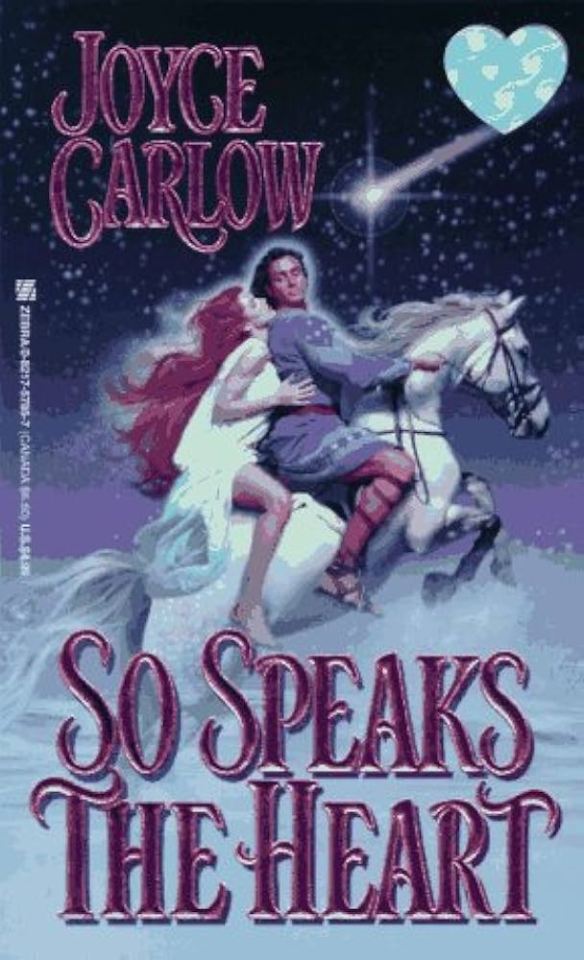
I had low expectations going in, and yet this was still somehow worse than I anticipated!
So Speaks the Heart—published in 1997, and currently available for free through the Internet Archive—was brought to my attention by @suburbanbeatnik last week, and the cover looked so absurd that I immediately knew I had to read it. And I tried. I really tried. But I ultimately ended up DNF'ing it around the halfway mark when the lead characters abruptly died, then reincarnated centuries later as different people in sixteenth-century France.
It technically makes more sense in context, but, like, barely.
The premise
So: The plot of this book revolves around "immortals"—vaguely supernatural beings who reincarnate every few centuries to steer historically important figures towards their destinies. Aside from possessing the ability to reincarnate, immortals are also beautiful, intelligent, infallible, and psychic, frequently receiving premonitions from the future, as well as insights into other people's minds. In some ways, they're like an unholy hybrid of stereotypical romance vampires and high-fantasy elves—their powers are as unclear as they are expansive, and their inherent beauty and goodness means that they can do no wrong. Our protagonists, a physician named Leandra and a charioteer named Alexander, are a pair of Immortals who were born in the sixth-century Byzantine Empire to steer Justinian and Theodora towards their fates as Emperor and Empress of Rome.
I'll admit at this point that I disliked this premise from the start. It's very Great Man History™, except the "great men" are random nobodies with vague, unattainable powers, pushing people around like chess pieces for reasons that are unclear to everyone involved. The magically-perfect, always-right nature of the Immortals also makes them dull characters to read, and blaming every historical event on Immortal meddling only serves to reduce the agency of the few humans in the story—the end result is a book where everyone is underdeveloped and boring. The Immortals don't need character development, because they were born perfect, and the humans don't get character development, because the Immortals do everything for them. I do think the concept of star-crossed lovers dying over and over again only to find each other in new lifetimes could have been done well, but it was wasted here, shackled to all of this weird baggage.
The characters
Leandra and Alexander obviously compose the "main" couple, but Justinian and Theodora also soak up a lot of page time, serving as the secondary, human protagonists to their perfect, Immortal friends. Leandra is the Immortal "assigned" to Theodora, like the most irritating kind of guardian angel, and Alexander is similarly "assigned" to Justinian, so all four of them come as a set. Every single one of these characters is terrible.
Leandra gets the most focus out of anyone, and consequentially, she is the absolute worst. She's the type of protagonist who can be generously described as an "escapist character"—again, because of her Immortal status, she's automatically right about everything, she receives special insights that nobody else understands, and she's beautiful beyond words (and way prettier than Theodora, obviously). She's also a virgin, which makes her even more special; while every other woman in the Hippodrome sells her body for fun, Leandra never gives into the temptation. (For what it's worth, the author doesn't harp on this as much as I expected, but it does come up more than once, and it's used as yet another metric by which to compare Leandra and Theodora—Leandra being superior, naturally.) Leandra also has medical training, by which I mean that she magically understands complex microbiological concepts that were not discovered until the Scientific Revolution. Not only does she believe in germ theory, she also understands what bacteria are, and how antibiotics work. How does she know these things? Because she's special. It's beyond aggravating—especially because the author has an incomplete understanding of what penicillin does, and as a result, Leandra does, too. Leandra spends half of the story spouting total nonsense, but the narrative treats it as correct, and any character who questions her is depicted as an idiot.
Outside of her interest in medicine, Leandra really has no personality. Her only goal in life is to get Theodora where she needs to be, so she spends most of the story just kind of orbiting Theodora like a satellite. This isn't even a conscious goal, though—Leandra has no idea what she's actually steering Theodora towards. Most of the time, her suggestions to Theodora are based on vague feelings and indecipherable prophecy dreams. It's the blind leading the blind—Leandra gives Theodora advice based on nothing, and Theodora follows that advice based on nothing, and they're both headed towards an end goal that neither of them understand. Everything they do is guided by feelings and instincts that they have zero control over. It's boring to read, and Leandra's sheer perfection, combined with her lack of agency, made me want to tear my hair out.
The male lead, Alexander, is not much better—his main character traits are “liking Leandra” and “being handsome,” and that’s about it. He actually begins the story as a nervous virgin, but then he buys a night with Theodora and, apparently, a personality transplant, and he’s a completely different person by the time he and Leandra actually get together. (Specifically, he transforms into a generic, stereotypical, pushy “bodice ripper” love interest, but the “bodice ripper” elements feel halfhearted, probably because he was nothing like that for the entire first half of the book). Theoretically, Alexander is meant to guide Justinian the way Leandra guides Theodora, but he doesn't seem to share Leandra's medical knowledge or psychic dreams, so it's unclear what Justinian is actually getting out of their friendship. Actually, it's unclear why any of these characters like each other at all, because, again, their friendships and romances are entirely determined by "fate." Why does Justinian hang out with Alexander? Fate. Why do Alexander and Leandra fall in love? You guessed it: because it's meant to be. Everything is insta-love or insta-friendship, with no relationship-building at all.
Aside from the two leads, Justinian and Theodora are the only other characters of note, and they're both... well, kind of stupid. Again, because their decisions are largely driven by Immortal meddling, they don’t get to make many choices of their own, and whatever choices they do make independently of the Immortals are shown to be incorrect. (For example, Theodora leaves with Hecebolus despite Leandra’s protests, which results in both Theodora and Leandra nearly dying.) Theodora at least gets a couple of cool scenes—she wins the Blues’ favor by somehow taming a snake (?!), and she does get (a truncated version of) her Nika speech. Justinian, though, barely does anything. Their romance, which serves as the B-plot to Leandra’s A-plot, is hardly even a romance—like every other relationship in this book, it’s underdeveloped insta-love driven by “fate.”
Oh, and finally, something else I felt the need to mention: Justinian and Theodora seem to have no friends or advisors outside of Alexander and Leandra. Belisarius, Antonina, Narses, Theodora’s Monophysite allies, Justinian’s sister and cousins and nephews, etc, are all totally absent from the story. Theodora’s sisters do appear once, but they vanish after their introductory chapter and are never seen again. I understand sidelining less important characters for the sake of keeping things concise, but it struck me as strange that so many people were casually cut from the narrative. I guess the author figured Justinian and Theodora would never talk to Alexander or Leandra if they had literally any other options.
The sex scenes
There are a lot of sex scenes in this book, which isn't necessarily problematic—I'm not a puritan. Unfortunately, the sex scenes are weird as hell. They're all cloaked in bizarre, convoluted metaphors, which is to be expected, but they're also odd in other ways:
The phrase "moist depths" is used more than once.
There's a lot of "moistness" and "dampness" at pretty much every turn, actually, and it gives off real un-sexy bog energy.
The word "pleasure" appears 8 times in rapid succession in the same sex scene. Other words that appear too often: "undulating," "pulsating," "throbbing," and "nipples." (Do I understand why these are used in sex scenes? Yes. Is it a lot of repetition that could have been worded differently? Also yes.)
Justinian and Theodora love each other so much that a "miracle" occurs when they have sex: Theodora is "incarnated anew," becoming "like a virgin again."
Leandra's guardian is a fellow Immortal who once had sex with Zenobia, and he fantasizes about having sex with her again as he lays dying, which makes for some weird tonal dissonance.
An evil Immortal named Cyril is depicted as an agent of the Empress Euphemia, and they are obviously having an affair with each other, and you can tell it's an evil affair because they do weird shit in bed.
Alexander calls Leandra "my little virgin" as a nickname.
Alexander verbally calls Leandra's breasts "pink-tipped mounds." Like, it's not a metaphor that the narrator uses; he says this out loud to her. It's not even part of a longer sentence. He's trying to seduce her, and the only thing that comes out of his mouth is fucking "pink tipped mounds" and that's it.
"He sucked strongly, like a hungry child" <- NOT A METAPHOR YOU SHOULD USE DURING A SEX SCENE.
"She excreted warm, wet moisteners to ease his passage" <- ALSO BAD, FOR DIFFERENT REASONS. "EXCRETED" IS THE WRONG WORD TO USE HERE.
The plague
About 90% of the plot of this story revolves around the plague, and plague is my specialty, so I'm about to go off here. (Feel free to skip this if you do not care about plague.)
So, Leandra is a physician. She receives medical training at some Byzantine school early on in the story—women, obviously, did not get to become physicians very often in the Byzantine Empire, but again, Leandra is special—and she is then appointed as Justinian and Theodora's Official Royal Court Doctor. Because Leandra is Immortal and Not Like The Other Scientists, she immediately figures out germ theory, basic immunology, antibiotics, and a host of other extremely complicated concepts. How does she figure this stuff out? Not from experimentation using the scientific method, or anything else that follows any kind of logic. Instead, she just gets flashes of insight, which she assumes are true, and then everybody operates as if her unproven theories are obviously correct. Why does she believe that disease is caused by microorganisms invading human tissue? Because She Just Does. Why does she know that inflammation is an immune response to injury or infection? Because She Just Does. Nobody questions her beliefs at all, even though they completely contradict the theories of seminal figures like Hippocrates and Galen, and they're based on such little evidence that nobody has any reason to trust her. She's not seeing microorganisms under microscopes—she doesn't know what a microscope is. She's just saying random shit that happens to be true for reasons nobody in the setting understands.
It's difficult to put into words why I find this so irritating, but I think a huge part of it is that it plays into an idea I really hate—namely, that the people of the past were stupid and unobservant, and that science is easy enough that they could've solved all of their problems with a few basic thought experiments. Leandra criticizes the people around her for having dumb, incorrect theories about medicine—but these people have no reason to think that their theories are wrong. Miasmic theory is a perfectly rational thing to believe in if you don't have microscopes, and you've never heard of a bacterium, but you have noticed that people who live in smelly, unsanitary conditions seem to get sick and die more often. Blaming "bad air" isn't stupid if that's all you have to go on! Germ theory isn't obvious if you can't see the germs! But Leandra knows better, because She Just Does, so everyone who disagrees with her is evil or stupid, and all of the good guys think she's the best doctor on Earth. It's infuriating, partially because it plays into the popular image of early medieval people being dumb and zealous (Leandra claims that Roman medicine was superior to Christian medicine, as if Roman medicine gels with modern germ theory at all?), partially because it makes Leandra all the more obnoxious, and partially because it misrepresents the history of microbiology and epidemiology in a way that I do not like.
Because Leandra discovering germ theory hundreds of years too early isn't special enough, she also goes on to discover penicillin (not named as such, but obviously penicillin), and I also hated this subplot. It plays out exactly like Alexander Fleming's 1928 experiments—Leandra leaves a bunch of cultures out on a lab bench, and finds them contaminated by mold when she returns, then she notices that the mold has seemingly prevented the growth of the infectious bacteria. She then puts this mold to use, and everyone acts like she invented a miracle cure. There are about eleven billion problems with this, but this review is long enough, so I'll just list a couple of them:
The most obvious issue here is that penicillin is fucking hard to isolate and use as a medication. Fleming did his first experiments with penicillium molds in the late 1920s, but pencillin wasn't deployed as a drug until the 1940s because it was so difficult to extract. Seriously, read the Wikipedia page on the isolation of penicillin. It took over a decade and cost a shitload of money, and that was with the technology of the early 20th century. You cannot take raw penicillium mold and cram it into people's wounds and expect it to cure them of plague. That is not how this works. (In fact, various ancient cultures were aware that certain fungi could prevent infections from worsening, but they couldn't identify or isolate the actual antibiotic compounds, which limited their use.)
Leandra somehow understands that she shouldn't feed her patients liquid penicillin, because their stomach acid might degrade the drug and prevent it from working, so she decides she needs to introduce penicillin into their bloodstreams. How does she accomplish this? By cutting people's buboes open and cramming them full of mold! And this is portrayed as the correct course of action, and a reliable way of getting medications into the blood.
Leandra's mold-shoved-into-buboes treatment has a 100% cure rate, and all of her patients survive. For reference, plague has a 13% fatality rate today if treated with IV antibiotics. It is an extremely dangerous disease. So either the author dramatically underestimated how lethal plague actually is, or we are meant to believe that Leandra's cure is more effective than modern medicine.
The author completely ignores pneumatic and septicemic plague—everyone who gets sick gets bubonic plague, period. I get that buboes and fleas are the first things that come to mind for most people when they think of plague, but if you're going to build your entire plot around your protagonist's inexplicable knowledge of Yersinia pestis, maybe consider its other presentations?
Relatedly, the author also ignores that plague can be spread from person-to-person, as well as through other means. Leandra seems to believe that flea bites are the only route of plague transmission, and this is presented as right. Leandra spends a lot of time handling infected tissues in her laboratory, getting up close and personal with infected patients, and having sex with her infected husband, and she never worries about getting sick herself, because plague is transmitted by fleas. She does die young, but only because an evil rival doctor stabs her out of envy—not because she's spent the past six months breathing nothing but aerosolized plague.
Other inaccuracies
Obviously, a lot of the science is wrong, but so is the history. The timeline is all muddled—plague hits Europe and becomes endemic before Justinian even rises to power, and then it spirals into a pandemic at some point before the Nika riots. Theodora is infected with plague (although she's cured by the mold), while Justinian remains healthy. The Hagia Sophia in its current form exists before the Nika riots even happen. Justinain doesn't start work on his law code until after Theodora gets the plague. You get the picture. Everything happens out of order, on a condensed timeline, so that Leandra and Alexander can experience the best Byzantium has to offer before they die young and reincarnate in sixteenth-century France. (I know less about France than I do about Byzantium, but for what it's worth, I suspect the French setting is also filled with research errors.)
The ending
I gave up on this book at some point after Leandra's first death, but I did skim the French part until I got to the ending, and I discovered that the scene on the cover—the picture of Leandra and Alexander riding a pegasus to the sky—does literally happen in the final paragraph. Nostradamus actually witnesses them flying into outer space as he's charting the movement of the stars.
For what it's worth, I think both Leandra and Alexander are anthropomorphic constellations at this point, if that makes it any better.
Final verdict
This book is insane. I've read a fair amount of wacky Byzantine romances, but this one is on another level. The premise alone is bonkers, the characters are all horrible, the sex scenes are absurd, and the science and the history are both so wrong that I don't even understand how we got to this point. I majored in microbiology, and I minored in medical humanities, so I know a fair amount about the history of infectious disease research, and this book feels like it was designed specifically to torment me. When I got to the penicillin subplot, I said "noooooo" to myself, out loud, like some kind of madwoman. This book has driven me to the brink of insanity. There weren't even any fucking birds in it.
10/10, would write a scathing review of again.
#reviews#So Speaks the Heart#Joyce Carlow#romance#Justinian I#Theodora#for what it's worth the book was terrible but I really enjoyed writing this post about it#it hit every single one of my pet peeves which is kind of impressive#bad characters! bad history! BAD MICROBIOLOGY! it was awful and I love complaining about it!#@suburbanbeatnik thank you so much for telling me about this it was very entertaining
6 notes
·
View notes
Text




Original art for The Book of Fate (1997) #3 & #6 covers. Pencils by Ron Wagner with inks by Bill Reinhold.
#the book of fate#the book of fate 1997#jared stevens#fate#bill reinhold#ron wagner#book of fate#book of fate 1997#dr fate#doctor fate#dc#dc comics#dcedit#comicedit#comicsedit#u can reblog
13 notes
·
View notes
Photo
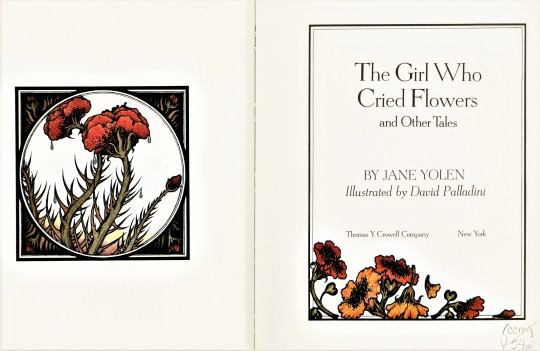
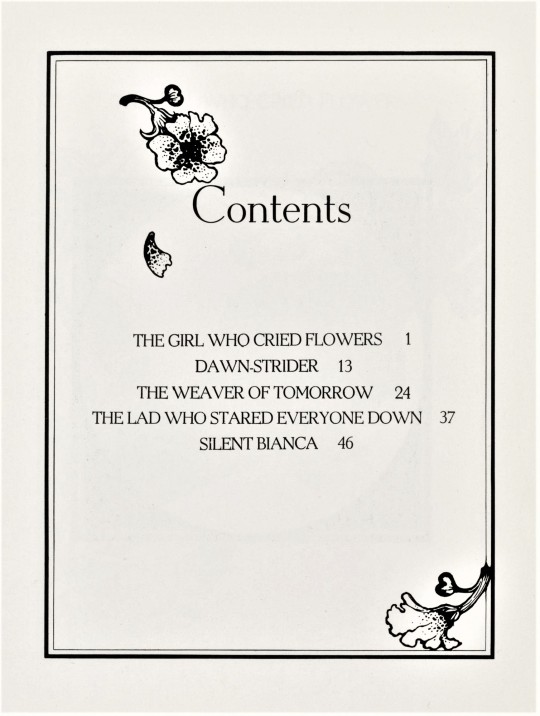
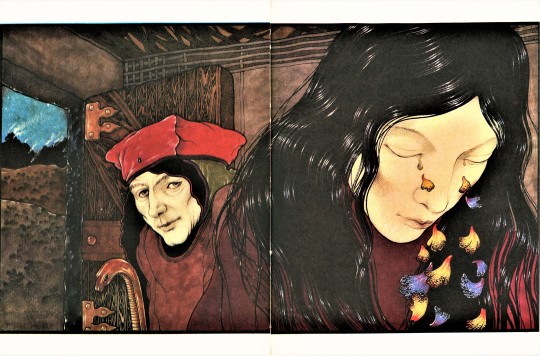
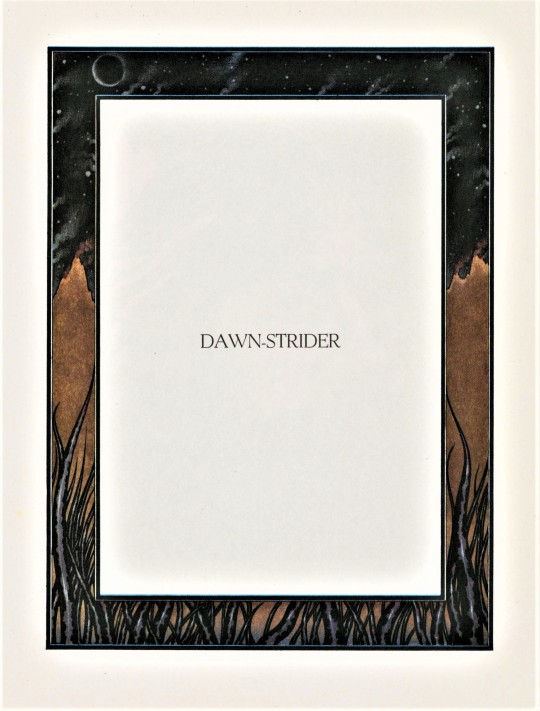
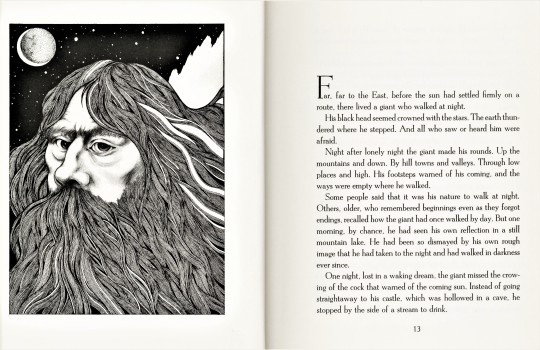

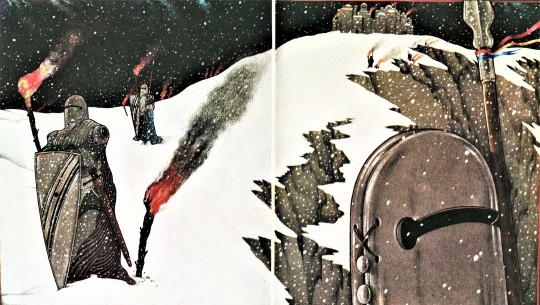
More Fairy Tales
This week I bring you The Girl Who Cried Flowers, and Other Tales, by the prolific American writer Jane Yolen (b.1939), illustrated by David Palladini (1946-2019), and published in New York by Thomas Y. Crowell in 1974. The book contains five original fairy tales with accompanying illustrations that range from one to two pages and are in both black and white and color. Tales such as these among her more than 300 titles has led Newsweek to dub Yolen “The Hans Christian Andersen of America.”
Yolen claims that it was this book, published nine years after her first book, that established her reputation in the field of children’s literature. The title story, The Girl Who Cried Flowers, has seen several iterations, including being separately published in Cricket magazine in 1990, published as an audiotape that Yolen narrated for Weston Woods Studios in their Readings to Remember series, and produced as an animated movie by Auryn Studios, with a script by Yolen, and directed by Bollywood director Umesh Shukla.
Yolen, who had originally worked as an editor, considered herself to be a poet and a journalist/nonfiction writer. Fate took her in a different direction, however, and to her surprise she became a children’s book writer who focused mostly on fantasy and science fiction. Her numerous awards andhonors include a Caldecott Medal, a Caldecott Honor, two Nebula awards, the Jewish Book Award, and six honorary doctorates.
Palladini, an Italian-born American illustrator, was best known for his Aquarian Tarot deck, which was published by Morgan Press in 1970 and reworked as the New Palladini Tarot in 1997 by U.S. Game Systems. Palladini’s style is reminiscent of the Art Nouveau illustrations of Alphonse Mucha and Aubrey Beardsley, a beautiful accompaniment to Jane Yolen’s stories.
View more posts from our Historical Curriculum Collection of children’s books.
View more Women’s History Month posts.
-- Elizabeth V., Special Collections Undergraduate Writing Intern
#women's history month#women writers#woman author of the week#Jane Yolen#David Pallandini#Thomas Y. Crowell Co.#The Girl Who Cried Flowers and Other Tales#fairy tales#children's books#illustrated books#Historical Curriculum Collection#Elizabeth V.
139 notes
·
View notes
Text
My aCoTaR fancast nobody asked for
Beware, this is a really long ride but I worked hard for it and spent more time than I want to admit doing my research so if you want to chat about my choices it would be appreciated
The Archerons
Abigail Cowen as Feyre Archeron

She’s talented, she’s good looking and she’s familiar with fantasy stuff, do I need to add more?
Age: 25 (March 18, 1998)
Height: 167 cm (5′6″)
Notable role(s): Dorcas in Chilling Adventures of Sabrina (2018), Bloom in Fate: The Winx Saga (2021) and Angel in Redeeming Love (2022)
Madelyn Cline as Elain Archeron

Her face is so sweeeet 🥰
Age: 25 (December 21, 1997)
Height: 167 cm (5′6″)
Notable role(s): Sarah Cameron in Outer Banks (2020)
Thea Sofie Loch Næss as Nesta Archeron

She’s like the perfect older sister 🤷🏼♀️
Age: 26 (November 26, 1996)
Height: 169 cm (5′7″)
Notable role(s): Skade in The Last Kingdom (2018)
The Spring Court
Calahan Skogman as Tamlin

I’m not taking criticism on this
Age: 29 (May 13, 1993)
Height: 193 (6′4″)
Notable role(s): Matthias Helvar in Shadow and Bones (2021)
Jan Luis Castellanos as Lucien Vanserra

If LoA+Helion is the way the show wants to go too, he’s the right choice.
Age: 27 (September 11, 1995)
Height: 175 cm (5′9″)
Notable role(s): Diego Torres in 13 Reasons Why (2020)
Anne Winters as Ianthe

Just look at her, please
Age: 28 (June 3, 1994)
Height: 160 cm (5′3″)
Notable role(s): Chloe Rice in 13 Reasons Why (2018)
Gugu Mbatha-Raw as Alis

Everything she stars in tends to be a success, so call it superstition but I want her to play the best maid Feyre could wish for (and which I hope to see again in the next books)
Age: 40 (April 21, 1983)
Height: 162 (5′4″)
Notable role(s): Talia in Larry Crowne (2011), Dido Elizabeth Belle in Belle (2013), Noni in Beyond the Lights (2014), Prema Mutiso in Concussion (2015), Esme Manucharian in Miss Sloane (2016), Janelle Brady in The Whole Truth (2016), Ava Hamilton in The Cloverfield Paradox (2018), Dr. Kate Murry in A Wrinkle in Time (2018) and Ravonna Renslayer in Loki (2021)
The Night Court
The Inner Circle
Staz Nair as Rhysand

If you all take my suggestion seriously before starting to rant, you will see it too. I know the age difference between him and Abigail Cowen is kind of huge, but she’s tough and I think she can handle it
Age: 31 (June 17, 1991)
Height: 185 (5′11”)
Notable role(s): Qhono in Game of Thrones (2016)
Chuku Modu as Cassian
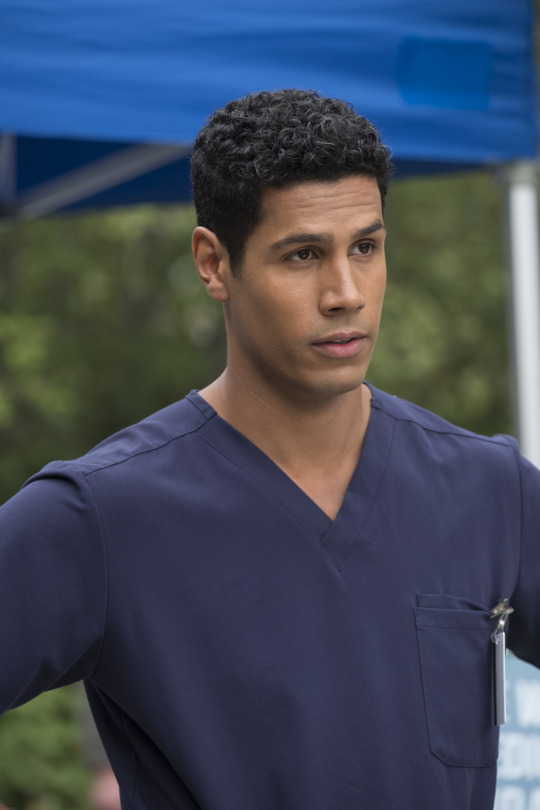
Give him long hair and a hint of beard and we’re good.
(No, I don’t want to hear you say Can Yaman is better.
No, I don’t want 37 yo Roman Reigns to star next to 25 yo Abigail Cowen and make sexual jokes nearly half of the time.
Yes, I’m aware he’s just five years younger than the aforementioned wrestler but five years sometimes are a big deal and they are now.)
Age: 32 (July 19,1990)
Height: 193 cm (6′4″)
Notable role(s): Aggo in Game of Thrones (2016) and Dr. Jared Kalu in The Good Doctor (2017)
Drew Ray Tanner as Azriel Shadowsinger

I know he’s cute but I bet he can make the tormented look work
Age: 31 (February 12, 1992)
Height: 178 (5′1′”)
Notable role(s): Fangs Fogarty in Riverdale (2017)
Halston Sage as The Morrigan

I don’t know if I want to be her or kiss her. Either way, what a bliss.
Age: 29 (May 3, 1993)
Height: 166 cm (5′5″)
Notable role(s): Lacey Pemberton in Paper Towns (2015)
Park So-Dam as Amren

The likelihood that she won't accept is very high, but if she were to, it would be wonderful
Age: 31 (September 8, 1991)
Height: 162 (5′4″)
Notable role(s): Kim Ki-jung in Parasite (2019)
The Valkyrie
Kirby Johnson as Gwyneth Berdara

If you have some influence in the matter, please help this girl to be casted in something different than a horror.
Age: 27 (February 12, 1996)
Height: 173 cm (5′8″)
Notable role(s): Hannah Grace in The Possession of Hannah Grace (2018)
Ella Balinska as Emerie

All hail our Illyrian queen, badass fighter, former netball player and part-time model
Age: 26 (October 4, 1996)
Height: 181 cm (5′11″)
Notable role(s): Jane Kano in Charlie’s Angels (2019)
Keeping Up with the Vanserras
I’m not going to cast the dead brothers, but if you have someone you feel like would fit in, I might add them to fill the void
Trevor Stines as Vanserra Brother n.1

I know he’s younger than Jan Luis Castellanos and taller than Ruairi O’Connor, but I want him to be a Vanserra so bad I have to put him here
Age: 26 (July 15, 1996)
Height: 185 cm (6′1″)
Notable role(s): Brett in The Amityville Terror (2016) and Jason Blossom in Riverdale (2017)
Dacre Montgomery as Vanserra Brother n.2

I think he’s good at playing the bad guy so he should be casted, period
Age: 28 (November 22, 1994)
Height: 176 cm (5′9″)
Notable role(s): Jason Scott / Red Ranger in Power Rangers (2017), Billy Hargrove in Stranger Things (2017) and Steve Binder in Elvis (2022)
Cameron Monaghan as Vanserra Brother n.3

IDK, I think he would like to play the deranged dude again, at least for a while
Age: 29 (August 16, 1993)
Height: 179 cm (5′10″)
Notable role(s): Ian Gallagher in Shameless (2011), Mason Ashford in Vampire Academy (2014), Asher in The Giver (2014), Jerome Valeska in Gotham (2015) and James Walker in Amityville: The Awakening (2017)
Ruairi O’Connor as Eris Vanserra

I just want to see this man more, I’m not even sorry for it
Age: 31 (July 9, 1991)
Height: 178 (5′10″)
Notable role(s): Henry VIII in The Spanish Princess (2019) and Arne Cheyenne Johnson in The Conjuring: The Devil Made Me Do It (2021)
Kristofer Hivju as Beron Vanserra

☑️ red hair
☑️ good beard
☑️ evil dilf vibe
Age: 44 (December 7, 1978)
Height: 183 cm (5′11″)
Notable role(s): Jonas in The Thing (2011), Tormund Giantsbane in Game of Thrones (2011), Connor Rhodes in The Fate of the Furious (2017) and Kristoffer in Cocainebear (2023)
Gemma Arterton as Lady of Autumn

By mortal standards she'd be a little too young to play Lucien and Eris' mother, but as the Fae age differently (and in a poorly explained way) in this universe, I'd appreciate her resemblance to Jan Luis Castellanos being exploited
Age: 37 (February 2, 1986)
Height: 170 cm (5′7″)
Notable role(s): Strawberry Fields in Quantum of Solace (2008), Io in Clash of the Titans (2010), Tamina in Prince of Persia (2010) and Gretel in Hansel & Gretel: Witch Hunters (2013)
Ismael Cruz Cordova as Helion

I know he’s light skinned but if we want to make the retcons and the plot twist work in the show he needs to be
Age: 36 (April 7, 1987)
Height: 178 (5′10″)
Notable role(s): Davide Rizzio in Mary Queen of Scots (2018) and Arondir in The Lord of the Rings: The Rings of Power (2022)
Hybern (and the possible prequel about the war)
Katharine McPhee as Amarantha

I have to be honest, I choose the actress for Clythia first but I think they kind of look alike so, why not?
Age: 39 (March 25, 1984)
Height: 170 cm (5′7″)
Notable role(s): Harmony in The House Bunny (2008) and Beth in Shark Night (2011)
Eleanor Tomlinson as Clythia

I don’t know about you but I want something more than a couple flashbacks of the war and since a TV show is not a first person POV, I want to go deeper into what happened at the time and for that, we need to cast the right girl
Age: 30 (May 19, 1992)
Height: 171 (5′7″)
Notable role(s): Isabel Neville in The White Queen (2013), Georgiana Darcy in Death Comes to Pemberley (2013), Demelza Carne Poldark in Poldark (2015), Georgie Raoul-Duval in Colette (2018) and Amy in The Wars of the World (2019)
Matt Smith as The King of Hybern

For my peace of mind, he needs to play someone who couldn’t be seen as an heartthrob
Age: 40 (October 28, 1882)
Height: 181 cm (5′11″)
Notable role(s): The Doctor in Doctor Who (2010), Thomas in Womb (2010), Alex/Skynet in Terminator Genisys (2015), Mr Collins in Pride + Prejudice + Zombies (2016), Prince Philip in The Crown (2016), Morgan in Patient Zero (2018), Jack in Last Night in Soho (2021), Richard Galloway in The Forgiven (2021), Milo/Lucien in Morbius (2022) and Daemon Targaryen in House of the Dragon (2022)
Dylan O’Brien as Jurian

Just watch his filmography and tell me he wouldn’t be the perfect Jurian
Age: 31 (August 26, 1991)
Height: 178 cm (5′10″)
Notable role(s): Stiles Stilinski in Teen Wolf (2011), Stuart Twombly in The Internship (2013), Thomas in The Maze Runner (2014), Mitch Rapp in American Assassin (2017) and Joel Dawson in Love and Monsters (2020)
The High Lords and their Courts
The Winter Court
Luke Baines as Kallias

He can be the James Marsters of our time
Age: 32 (June 8, 1990)
Height: 179 cm (5′11″)
Notable role(s): Jonathan Morgenstern in Shadowhunters (2019)
Sasha Luss as Viviane
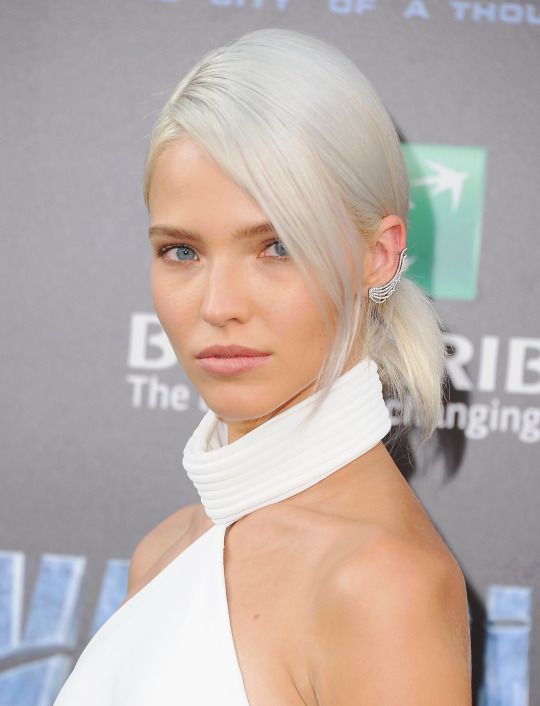
Before I found out the Samos siblings are half asian, I wanted her to play Evangeline in the Red Queen adaptation. Now is my time to shine
Age: 30 (June 6, 1992)
Height: 178 cm (5′10″)
Notable role(s): Princess Lihio-Minaa in Valerian and the City of a Thousand Planets (2017) and Anna Poliatova in Anna (2019)
The Summer Court
Micheal Ward as Tarquin

I'm starting to think I should have put the fanart that inspired me because in this case the resemblance is uncanny
Age: 25 (November 18, 1997)
Height: 175 (5′9″)
Notable role(s): Brendan in The A List (2018)
Coco Jones as Cresseida

Disney Channel mistreated her, I won't
Age: 25 (January 4, 1998)
Height: 178 cm (5′10″)
Notable role(s): Roxanne “Roxie” Andrews in Let It Shine (2012) and Hilary Banks in Bel-Air (2022)
Kelvin Harrison Jr. as Varian

Can he have white dreads instead of just white hair?
Age: 28 (July 23, 1994)
Height: 170 cm (5′7″)
Notable role(s): Mason in Assassination Nation (2018) and B.B. King in Elvis (2022)
The Dawn Court
Evan Evagora as Thesan

Aaaaaand... you made it to the end. Thank you to everyone who took the time to read my silly comments and please don’t start a war in the comments, this is just for fun
Age: 26 (August 10, 1996)
Height: 186 cm (6′1″)
Notable role(s): Elnor in Star Trek: Picard (2020)
#acotar fancast#the archeron sisters#feyre archeron#elain archeron#nesta archeron#spring court#tamlin#lucien vanserra#ianthe#alis#night court#rhysand#cassian#azriel shadowsinger#inner circle#the morrigan#amren#the valkyries#gwyneth berdara#emerie of illyria#autumn court#eris vanserra#lady of autumn#loa#helion#beron vanserra#amarantha#clythia#king of hybern#jurian
52 notes
·
View notes
Note
what's your favourite fictional leopold and loeb retelling? Book/movie/musical/anything!
Thank you for your question!
Ooo that's a tricky one, there's so many possibilities!
As far as my favorites objectively, which I think I'd like even if I didn't know the Leopold-Loeb story, I'd say Funny Games (1997), Rope (1948) and Scream (1996), none of which are really about Leopold and Loeb at all, haha.
But for the ones that really adapt the story/characters I'd say Never the Sinner by John Logan, Little Brother Fate: The Cold and the Dark by Mary Carter-Roberts, Nothing But the Night by James Yaffe, The Hunting Accident by Landis Blair and David Carlson, Compulsion (1959) and the Laural Meade play trilogy
I think These Violent Delights by Micah Nemerever is really good but man is it depressing in Paul's POV for so many pages, so I don't really reach for it a lot.
Shout outs to The Nice Boys by Isabel Colegate and The Death of Dickie Draper by Jerome Weidman too!
16 notes
·
View notes
Text
Why does no one ask, Master Who?: (#1 - Koschei)
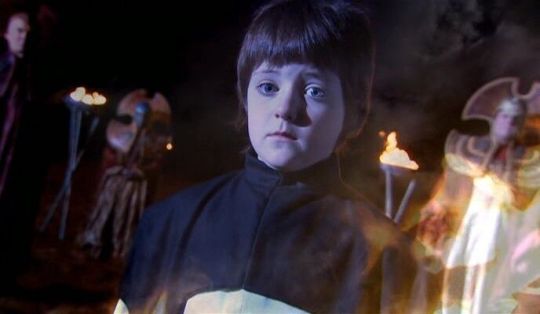
Why does no one ask, Master Who?: A Character Study Series
This was one subject I was excited to cover, especially after just recently getting into Russian folklore. And of course since this is technically the first master (as according to the fandom, EU content, and The Sound of Drums ), this had to be the one to cover first (especially because of the symbolism present here that I feel is so important to beginning our journey exploring who the Master is.)
Though the young first Master’s name is never revealed to us in the show, how did we get the name Koschei? Let me direct you to the way of the Extended Universe.
May I introduce you to a series of wonderful books?
Let’s start with the one that introduced the name Koschei for the Master:

1. The Dark Path by David A. McIntee (published March 1997)
A wonderful novel that features one of the earliest encounters with the Master and the Doctor, greatly expanding on their personal histories on Gallifrey. This story in particular is iconic because it’s one of the many origin stories explaining how/why he became the Master. I honestly don’t wanna spoil it for those who have yet to read it, but I did leave a spoiler review on my main blog awhile back.
This book is important, however, because this is where the Koschei name began. As the book states, this is the name he was going by before he decided to take the title; The Master, by the end of the book.

2. Divided Loyalties by Gary Russell (published October 1999)
2 years later, this book was released. It’s another fantastic novel which is iconic for showing the begins of the Deca and giving us a glimpse into the childhood’s of the Doctor, the Master, the Rani, and so on. I also don’t want to spoil this for those who haven’t read it. Honestly, it’s an experience, and I’ve posted about it a lot on my main.
However, it also features the Master using the name ‘Koschei’, but in the Academy! And when alluding to the characters fates at the end, it even mentions what happens in McIntee’s ‘The Dark Path’.
Bonus: It is also the book that gives us the Master’s house as being Oakdown, hence most of the fandom calling the young Master; Koschei Oakdown.
So, still....Why the name, Koschei?
What is the significance of it? Where did it even come from?
The answers lie in a character from Russian Folklore...
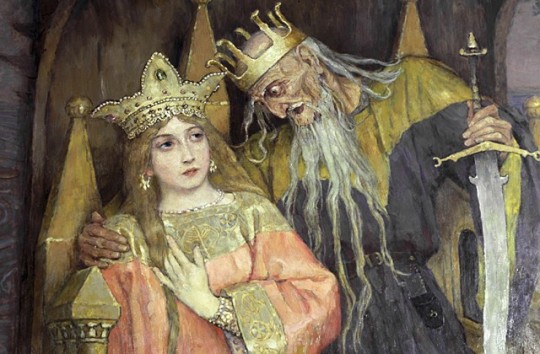
Koschei the Deathless (aka the Immortal)
As the wiki describes: “He is an archetypal male antagonist in Russian folklore. The most common feature of tales involving Koschei is a spell which prevents him from being killed. He hides his soul inside nested objects to protect it. For example, the soul (or in the tales, it is usually called "death") may be hidden in a needle that is hidden inside an egg, the egg is in a duck, the duck is in a hare, the hare is in a chest, the chest is buried or chained up on a far island. Usually he takes the role of a malevolent rival father figure, who competes for (or entraps) a male hero's love interest.”
Sounds kind of familiar, right?
It’s very symbolic to who the Master becomes:
Someone always managing to cheat death, and never being really killed off.
Being the constant rival of the Doctor, sometimes abducting his companions.
In some tales, Koschei can cast a sleep spell, almost like how the Master hypnotizes others.
Not to mention, having a fascination with the Russian culture as shown especially in Dhawan’s era.
#master who series#the master#master meta#koschei#koschei oakdown#doctor who#dweu#doctor who eu#koschei the deathless#doctor who meta#the deca
80 notes
·
View notes
Text
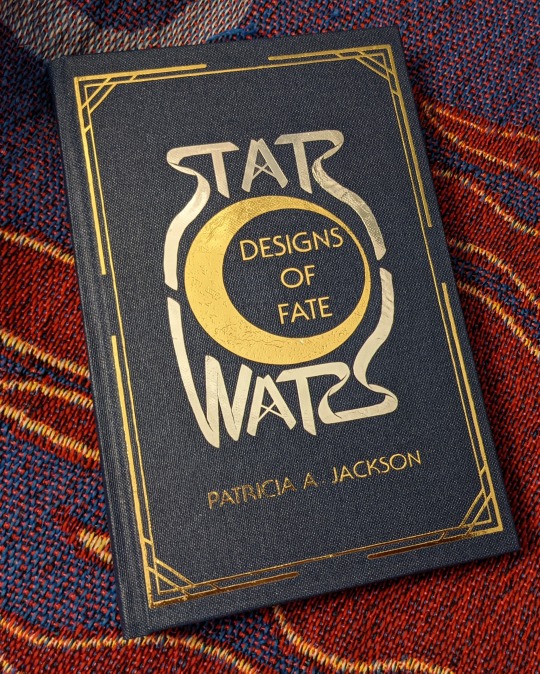
Editor's Note from my bind, Designs of Fate, an anthology of Star Wars stories by Patricia A. Jackson.
Patricia A. Jackson is a criminally underrated Star Wars author.
I’ll explain.
Growing up in the late 1990s and early 2000s, it was challenging to be an adolescent Star Wars fangirl, particularly an Asian American one. Back then, fandom meant negotiating male-dominated online message boards where identifying as a teenage girl meant inviting a ‘fake geek girl’ grilling at best and sexual harassment at worst. Most of the published Star Wars books were about Han, Leia, and Luke. Han and Leia were in their thirties and the parents of three children...not super relatable for preteen me. As far as character development was concerned, our “Big Three” had established characterizations coalesced firmly on the side of good. For our heroes, there was no moral ambiguity as, novel by novel, they tackled the galactic Threat of the Week.
Bildungsromans, those books were not. When Jackson started writing Star Wars in the 1990s, there were no women Jedi or protagonists of color. If you wanted stories with original characters coming of age, your primary recourse was the West End Games’ Star Wars Adventure Journals and their published anthologies, Tales from the Empire (1997) and Tales from the New Republic (1999). I remember avidly poring over my dogeared paperback copies and stalking the internet for scans or transcriptions. Although I never played the D6 role-playing game, the short stories from the Star Wars Adventure Journals helped me envision that a character like me—a young Asian girl coming into her own—did have a place in Star Wars after all.
As evinced by the vitriolic reactions towards John Boyega and Kelly Marie Tran during the production of the sequel trilogy, Star Wars fandom can be a hateful environment for proponents of diversity and inclusion. A small but irritatingly loud faction of fascist-leaning, cishet, white male fans are actively hostile towards fans who advocate for change; they are more troubled by the presence of queers, women and BIPOC than our absence. Because of the ubiquity and popularity of Star Wars in America’s cultural milieu, the sentiments from these self-appointed gatekeepers have been—and continue to be—amplified by right wing extremists, and, to some extent, even by the Internet Research Agency as tools of Russia’s psychological and cyber warfare against the United States. During his Ph.D. candidacy with the Department of Information Studies at UCLA, Morten Bay, PhD., studied negative tweets about The Last Jedi and found that 50.9% of negative tweets were “bots, trolls/sock puppets or political activists using the debate to propagate political messages supporting extreme right-wing causes and the discrimination of gender, race or sexuality.”
“Russian trolls weaponize Star Wars criticism as an instrument of information warfare with the purpose of pushing for political change,” he wrote, “while it is weaponized by right-wing fans to forward a conservative agenda and for some it is a pushback against what they perceive as a feminist/social justice onslaught.”
The creation and inclusion of characters with minoritized identities in Star Wars is, therefore, an act of resistance. As far as I’m aware, Patricia A. Jackson was the first woman of color and Black author to write for the Star Wars expanded universe. Jackson has described the fan environment in the 1990s thusly; like many minoritized fans of color, she would be given pithy justifications such as "Well, there’s no Africa in Star Wars, so there are no Black people." Jackson noted, aptly, "That was just translation for “’You don’t matter. You don’t need to be here.’” Jackson's work for West End Games, particularly her sourcebook The Black Sands of Socorro, is a subversion of those expectations.
Before anyone else did, Jackson showed fandom that dominant mayo masculinity did not have to be the only way to tell Star Wars stories. Her stories existed before the prequel trilogy and three decades of Star Wars publishing, before FanFiction.net, Archive of Our Own, or Wattpad. She is the forerunner for BIPOC writers in Star Wars, followed by other luminaries like Steven Barnes, Daniel José Older, Nnedi Okorafor, Rebecca Roanhorse, Ken Liu, Greg Pak, Alyssa Wong, Sarah Kuhn, Saladin Ahmed, C.B. Lee, Justina Ireland, Alex Segura, Zoraida Cordova, Greg VanEekhout, Mike Chen, Charles Yu, R.F. Kuang, Sarwat Chadda, Sabaa Tahir, and Renée Ahdieh.
Jackson had and continues to have an incredibly prescient understanding of what makes a good Star Wars story. Any of the stories in this anthology could find a home as an anime short from Star Wars: Visions (2021). Ideas from Jackson’s Star Wars short stories have appeared in later media, sometimes decades later. Whether convergently evolved or directly influenced, the parallels are astonishing: Kierra, the snarky feminine droid consciousness who inhabits Thaddeus Ross’s ship, is a spiritual predecessor to L3-37, Lando Calrissian’s snarky feminine droid companion from Solo (2018) who ends the film uploaded to the Millennium Falcon. Jackson addressed concepts like slavery and Force healing predating the prequel and sequel trilogies. In “Idol Intentions,” she created an adventuring academic on the hunt for artifacts long before Kieron Gillen brought Doctor Aphra to life. Squint and the upturned red salt on the planet Crait in The Last Jedi becomes flying red soil on the planet Redcap. Dark haired, dark side tragic emo boy starcrossed with a fiery girl Jedi?—I think Jackson understood intuitively the appeal of this trope to a woman-dominated contingent of fandom well before “Reylo” topped Tumblr’s fan favorite relationship charts in 2020.
Jackson’s work is also significant for deepening world building. Much like how Timothy Zahn introduced analysis of fine art to Star Wars with his villainous art connoisseur Grand Admiral Thrawn, Jackson’s stories introduced concepts such as the evolution of Old Corellian, the acting profession, and Legitimate Theatre. These elements added verisimilitude to the expanded universe; it makes sense that different cultures in Star Wars would have archaic languages, folk songs, and old stories of their own from even longer ago in galaxies far, far, away. More recently, the franchise has started to flesh out in-universe lore in Star Wars: Myths and Fables (2019) by George Mann. Still, Uhl Eharl Khoehng in “Uhl Eharl Khoehng” (1995) remains the finest example of mise en abyme in any Star Wars related work.
Themes from Jackson’s Star Wars works, particularly around Drake Paulsen and Socorro, also connect contemporaneously with our real world. When the Seldom Different is essentially ‘pulled over’ by Imperial authorities in “Out of the Cradle” (1994), stormtroopers lie about Drake Paulsen having a weapon as a pretense to terrorize the teenager. It’s a collision of space opera with Black youths’ past and current experiences of police brutality and state-sanctioned violence. Accordingly, this capricious encounter is the rite of passage that jars Drake out of his childhood. I cheered when I read The Black Sands of Socorro (1997) and saw that the Black Bha'lir smuggler’s guild is named for a bha'lir, depicted in the book as a large...panther. Few Star Wars expanded universe authors—particularly in the 1990s—leveraged their influence to center characters of color or to allude to racial justice movements. Jackson did both.
For this anthology, I have copy edited and also taken the liberty of, when applicable, substituting some gendered or sanist language with more contemporaneous wording.17 The stories are otherwise intact. It would be remiss of me if I did not note; however, that one of the stories, “Bitter Winter” (1995), has sanist and ableist tropes that could not be contemporized without making dramatic changes to the story. In this story, the fictional disease brekken vinthern drives those impacted to violence; while it’s real world correlate of major neurocognitive disorder can include symptoms of aggression and agitation, extreme violence is rare and people with this condition are also at great risk of being harmed by violence. The tropes “Mercy Kill” and “Shoot the Dog” are depictions of non-voluntary active euthanasia, typically from the perspective of the horrified “killer” placed in an impossible situation. These tropes frame murder and death as “putting someone out of their misery” while downplaying any alternatives (ie: sedation to alleviate suffering, medical attention, or, say, ion cannons to render a ship inoperable without killing.)
Like in our society, the societies in Star Wars have consistently framed mental illness pejoratively. There are certainly valid critiques of the utter inadequacy of health care in Star Wars. Ableism is ubiquitous in entertainment media, and even with it’s problematic tropes, “Bitter Winter” remains one of the more humanizing depictions of a mental health condition in Star Wars fiction. I have included it in this anthology as a rare example of moral ambiguity in the franchise.
With the exception of “Fragile Threads” and “Emanations of Darkness,” the stories here are presented not in published order, but in chronological order as they would have occurred in the Star Wars universe. Ordering the stories chronologically helped clarify timelines; it also allows the anthology to begin with “The Final Exit,” which was a fan favorite back when it was first published. I’ve interwoven the Brandl family stories with Drake Paulsen’s coming of age adventures, as the Paulsens are such a strong foil to the Brandl family.
Since “I am your father” dropped in 1980, Star Wars has been big on Daddy Issues—intergenerational trauma, parental relationships, broken attachments, identity development, and initiation into adulthood (or, as Obi-Wan Kenobi would put it, “taking your first steps into a larger world.”) With Drake, we see that Kaine Paulsen is a father who is gone but ever-present. With Jaalib, we see that Adalric Brandl is a father who is ever-present but clearly far gone. Drake knows his Socorran roots; he has community and found family. Fable’s identity is adrift; she was torn from her roots after her fugitive Jedi mother’s death. Jaalib’s roots are scaffolded by disingenuous artifice. There is a diametric interplay of identity formation and parental legacy in these short stories that captures classic themes from Star Wars. And, the stories challenge readers to consider how we interact with shame, guilt, and obligation. Through the morally ambiguous dilemmas that are her oeuvre, Jackson’s characters discover who they are and where they stand.
While the thrill of having an Imperial Star Destroyer drop out of hyperspace is pure Star Wars energy, Jackson’s stories also disrupted what fans had come to expect. Published online as fan fiction, “Emanations of Darkness” (2001) polarized fans of the previous Brandl stories, particularly with Fable’s decision to throw her lot in with Jaalib and his father. At the time, Star Wars fan commentator Charles Phipps noted how the story dealt with the insidiousness of the dark side by taking potential heroes and crushing them. “Star Wars, I've never known to leave a bitter taste in my mouth,” he wrote, stunned. “I don't like what it's brought out in my feelings or myself...Bravo Brandl, you have your applause.” Although the Brandl stories were written and published before Revenge of the Sith (2005), Fable and Jaalib’s relationship mirrors the relationship between Padmé Amidala and Anakin Skywalker, down to both Jaalib and Anakin selling their souls to the same Emperor in hopes that will spare the women they love.
The prequel trilogy introduces the Jedi Council’s detached approach to attachments—don’t feel it, emotions like fear or anger are to be shunned, else suffering will follow. Anakin Skywalker’s broken attachments to his mother and Padmé lead him to turn against his values; his inability to integrate or tolerate his attachments is his downfall. It’s the same in the Brandl stories where, trauma bonded, Fable and Jaalib cannot let each other go. While Jaalib credits this as how he was able to preserve a bit of himself while under the Emperor’s thrall, his inability to extricate himself from his father’s influence or to let go of Fable ends up dooming her.
This is why I was thrilled to discover “Fragile Threads” (2021) on Wattpad twenty years later. In this story, Drake Paulsen helps his lover Tiaja Moorn save her sister, at the cost of losing their relationship when she decides to remain on her homeworld. Drake doesn’t fight her decision, he accepts it. He can hold onto that connection to Tiaja, just as he knows he will always be connected to Socorro, his father, and the Black Bha'lir. Drake can love freely because he knows what Luke Skywalker told Leia in The Last Jedi: “No one is ever truly gone.” He is able to straddle the fulcrum of attachment and love without letting it consume him, and that is balancing the Force.
Contemporary fandom discourse is also a struggle with attachment; the parasocial relationships we form with characters and stories are similar in process to how we attach to the important people in our lives. We imbue with meaning and carry these stories with us. As Star Wars storytelling enters its fifth decade, the divide between affirmational fandom (allegiance to manufactured nostalgia) and transformational fandom (allegiance to iterative and transgressive fan engagement) has factionized fandom. When Star Wars is seen as a totemic object, right wing fans have agitated for a return to a mythic past where white men were centered and morality was Manichean. From where I stand, at the heart of this debate is whether or not the reader or Star Wars is permitted to “grow up”—to leave the cradle, to evolve new identities and explore shades of grey.
To me, Jackson’s stories are a reminder that characters of color and complex moral dilemmas have always been a part of Star Wars. We have always been here. No other Star Wars author has been as exquisitely aware of the significance of storytelling; how it can help people challenge existing beliefs and discover themselves. Since the beginnings of the expanded universe, Patricia A. Jackson has spun yarn, and those fragile threads have tethered readers like myself to a galaxy far, far away.
Ol'val, min dul'skal, ahn guld domina, mahn uhl Fharth bey ihn valle. (Until we next meet, may the Force be with you.)
#star wars legends#patricia a jackson#star wars adventure journal#swrepmatters#binders note#patricia a. jackson#fanbinding
10 notes
·
View notes